Cobden and the Anti-Corn Law League
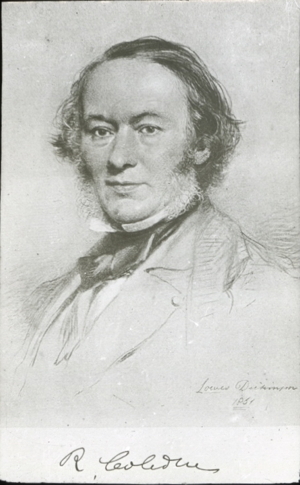 |
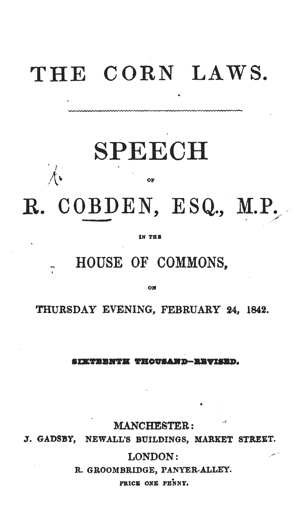 |
|
|
These illustrations about Richard Cobden and the Anti-Corn Law League (ACLL) (1838-1846) accompany the Liberty Matters online discussion "Richard Cobden: Ideas and Strategies in Organizing the Free-Trade Movement in Britain" which was held in January 2015.
Table of Illustrations
- Illustration 1: Poster celebrating the Repeal in June 1846
- Illustration 2: Portrait of Richard Cobden
- Illustration 3: Richard Cobden (1804-1865)
- Illustration 4: John Bright (1811-1889)
- Illustration 5: Busts of Bright and Cobden
- Illustration 6: Ebenezer Elliott (1781–1849), the "Corn Law rhymer"
- Illustration 7: George Wilson (1808–1870)
- Illustration 8: Thomas Perronet Thompson (1783-1869)
- Illustration 9: Charles Pelham Villiers (1802–1898)
- Illustration 10: A Meeting of the ACLL Council (with key)
- Illustration 11: Membership Cards for the National ACLL
- Illustration 12: ACLL Badge or Button
- Illustration 13: ACLL Medallion
- Illustration 14: TP of Elliott, the "Corn-Law Rhymer"
- Illustration 15: TP of Perronet Thompson's Corn-Law Fallacies
- Illustration 16: A mass produced copy of one of Cobden's Speeches in the House
- Illustration 17: TP of a presentation copy of key ACLL literature
- Illustration 18: First page of Peronnet Thompson's Catechism
- Illustration 19: First page of a dialogue between a Gentleman and a Farmer
- Illustration 20: Some of Elliott's "Corn-Law Hymns"
- Illustration 21: Embossed cover of the ACLL Presentation copy of key literature
- Illustration 22: Page where the recipient's name can be written
- Illustration 23: More detailed image of embossed cover
- Illustration 24: Illustrated ACLL envelope with accompanying poem by Horatio Smith
- Illustration 25: A Song calling for the "Abolition of the Corn Laws"
- Illustration 26: A large public meeting of the ACLL held at Exeter Hall, London (1846)
- Illustration 27: A Poster urging People to "Register" their Names on a Petition to Parliament
- Illustration 28: Advertisement for an ACLL fundraising Bazaar in Manchester
- Illustration 29: A china figurine of Cobden
- Illustration 30: Illustration of an ACLL Bazaar (with a cartoon from Punch)
- Illustration 31: An Invitation to an ACLL "Tea Party"
- Illustration 32: Illustrated envelopes with ACLL imagery
- Illustration 33: PM Sir Robert Peel
- Illustration 34: Cartoon of Peel "confessing his sins" to Cobden
- Illustration 35: Bright, Cobden, Chevalier in 1860 for the signing of the Anglo-French Trade Treaty
- Illustration 36: Page 1 of the Treaty
- Illustration 37: Page 2 of the Treaty
- Daumier Cartoons of Cobden, Bright, and the Peace Movement in 1856
- Daumier 1: Song of Jubilation (11 Feb. 1856)
- Daumier 2: The Return of the Golden Age (12 Feb. 1856)
- Daumier 3: Triumphal March (25 Feb. 1856)
- Daumier 4: Cobden's Anger (9 April, 1856)
- Daumier 5: Cobden, Bright and Gladstone only moderately happy (14 Apr. 1856)
- Daumier 6: Cobden, Bright, and Sturges have too much leisure (18 Apr. 1856)
- Daumier 7: Cobden, Bright, and Sturges no longer having anything to do in Europe (19 Apr. 1856)
- Daumier 8: Cobden finding things to do in Peace time (23 Apr. 1856)
- Daumier 9: The Three Friends of Peace wage War (28 Apr. 1856)
- Illustration 39: The Second Series of Cobden Club Essays (1871-72)
- Illustration 40: Cobden Club edition of Bastiat's Economic Sophisms (1909)
- Illustration 41: Jane Cobden (1851-1947)
- Illustration 42: Campaign Poster for the London County Council Election 1889
- Illustration 43: TP of "Land Hunger" (1913)
- Illustration 44: TP of "The Hungry Forties" (1904)
- Illustration 45: Page 1 from a Letter from Cobden republished in Jane's The Hungry Forties (1904) showing him working on ACLL designs for anti-protectionist imagery
- Illustration 46: Page 2 from a Letter from Cobden republished in Jane's The Hungry Forties (1904) showing him working on ACLL designs for anti-protectionist imagery
- Illustration 47: Frontispiece showing the "Fairy Wheatsheaf"
- Illustration 48: TP of a book celebrating the 50th Anniversary of Repeal (Aug. 1896)
- Illustration 49: A Jubilee Pie Plate
- Illustration 50: Thackeray, Illustrations Of The Rent Laws I, "Poles offering Corn" (1839)
- Illustration 51: Thackeray, Illustrations Of The Rent Laws II, "The Choice of a Loaf" (1839)
- Illustration 52: "Free Trade Shop vs. Protection Shop (c. 1905-10)
- Illustration 53: "An Eye Opener" (c.1905-10)
- Illustration 54: "How the Tories Have Increased the Cost of Living" (c.1905-10)
- Illustration 55: "Vote for Tariff Reform" (c.1905-10)
- Illustration 56: Imperial Tariff Committee: "A Free Trade Forecast" (c1905-10)
- Illustration 57: Richard Cobden Obelisk (Map), Cocking Causeway (1868)
- Illustration 58: Richard Cobden Obelisk 1, Cocking Causeway (1868)
- Illustration 59: Richard Cobden Obelisk 2, Cocking Causeway (1868)
- Illustration 60: Richard Cobden Obelisk (inscription), Cocking Causeway (1868)
- Illustration 61: The American Free Trade League: The Free-Trader (1870-71)
- Illustration 62: The American Free Trade League: The People's Pictorial Tax-Payer (1870)
- Illustration 63: The New York Free-Trade Club: Statement of Principles (1883)
- Illustration 64: The New York Free-Trade Club: "Cheap Free-Trade Literature" (1883)
- Illustration 65: The New York Free-Trade Club: Dinner Menu at Delmonico's (1885)
- Illustration 66: The New York Free-Trade Club: Dinner Toasts at Delmonico's (1885)
Introduction
The Corn Laws ("corn" is British English for grain) were introduced in 1815 to protect British farmers from competition from cheaper imported grain [Importation Act 1815 (55 Geo. 3 c. 26)]. Before imports would be permitted the price of British grain would have to exceed 80 shillings a quarter (480 pounds). Liberal political economists objected to the laws on the grounds that they itnerfered with the freedom to trade, forced ordinary consumers to pay higher prices than they would otherwise pay, and benefited the landowning class (in many cases aristocratic). A group of northern manufacturers and businessmen formed a lobby group, the Anti-Corn Law League, in 1838 to agitate for the repeal of the corn laws, which they succeeded in doing in June 26, 1846.
The Anti-Corn Law League (ACLL) was unusual in that for the first time modern techniques were used to attracted supporters in large numbers in order to put pressure on politicians to abolish a piece of legislation. These techniques ranged from membership drives, fund-raising activities, the collection of signatures, public meetings addressed by a body of paid professional speakers, merchandizing, as well as more traditional techniques of mass-produced cheap literature such as pamphlets. This collection of images shows how the ACLL went about its business, with a special focus on the visual dimension of their activities.
|
Illustration 1: Poster celebrating the Repeal in June 1846↩ |
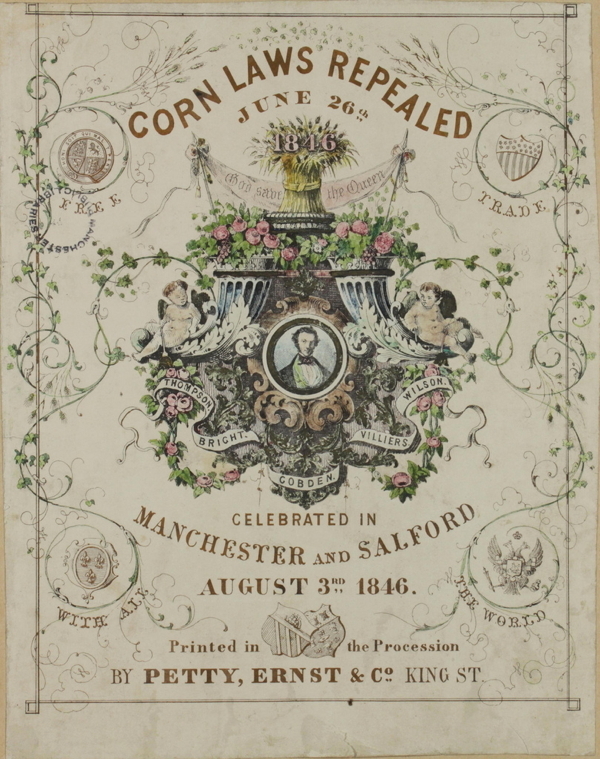 |
|
A poster celebrating the repeal of the corn laws on June 26, 1846 which was held in Manchester and Salford on Aug. 3, 1846.
[Note: the sheaf of corn (wheat) with the banner "God save the Queen" (Victoria assued the throne in 1837); the four circles with images and the words "Free Trade with All the World"; the central image of Cobden and the banner with the names of the five leading figures in the movement: (Thomas Peronnet) Thompson, (John) Bright, (Richard) Cobden, (Charles Pelham) Villiers, and (James) Wilson.] |
Key People
|
Illustration 2: Portrait of Richard Cobden↩ |
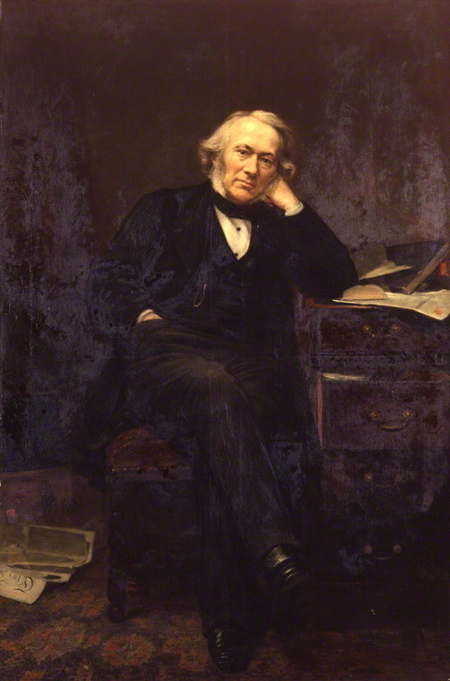 |
|
Richard Cobden (1804-1865)
|
|
Illustration 3: Richard Cobden (1804-1865)↩ |
Illustration 4: John Bright (1811-1889)↩ |
 |
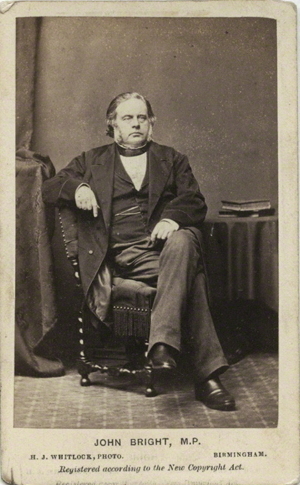 |
|
Cobden was a member of the British Parliament and an advocate of free trade, a non-interventionist foreign policy, peace, and parliamentary reform. He is best remembered for his activity on behalf of the Anti-Corn Law League which helped reduce British tariffs in 1846 and for negotiating the Anglo-French trade agreement of 1860. |
Bright was a Quaker and a Member of Parliament who was active with Richard Cobden in opposing the Corn Laws and the war against Russia in the Crimea. |
|
Illustration 5: Busts of Bright and Cobden↩ |
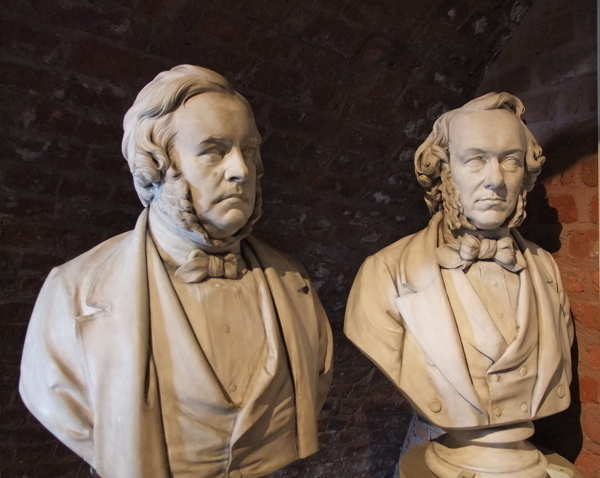 |
|
|
|
Illustration 6: Ebenezer Elliott (1781–1849), the "Corn Law rhymer"↩ |
Illustration 7: George Wilson (1808–1870)↩ |
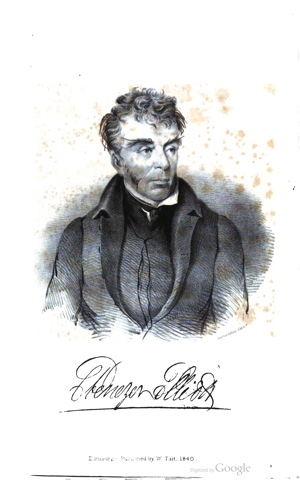 |
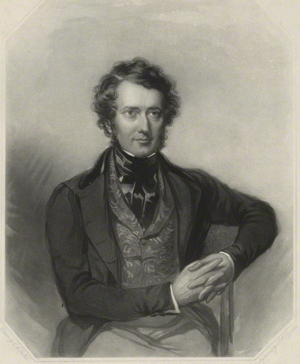 |
|
Ebenezer Elliott (1781–1849) was a factory owner and supporter of the free trade movement because he believed that protection led to higher food prices which harmed the welfare of the poor. He is best known for writing several volumes of political poetry for which he became known as the "Corn Law rhymer". [See below for an example.]
|
George Wilson (1808–1870) was a Manchester corn merchant and later railway entrepreneur. He was a member of the Manchester Town Council and then Chairman of the ACLL between 1841 and its dissolution after Repeal in 1846. He was the organising genius behind the successful fund raising Bazaars held in Manchester and London. [See the images below of the ACLL bazaars.]
|
|
Illustration 8: Thomas Perronet Thompson (1783-1869)↩ |
Illustration 9: Charles Pelham Villiers (1802–1898)↩ |
 |
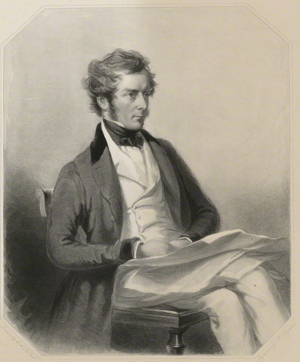 |
|
Thompson had a colorful career as a soldier, politician, polymath writer and pamphleteer, and agitator for the Anti-Corn Law League. He was a member of the Philosophical Radicals who were inspired by utilitarian and reformist ideas of Jeremy Bentham. Thompson was active in urging Catholic emancipation, the repeal of the Corn Laws, and the abolition of slavery, and played a leading role in managing the reformist journal the Westminster Review. [See below the extract from his Catechism on the Corn Laws.]
|
Charles Pelham Villiers (1802–1898) served in the House of Commons from 1835 to 1898 which made him the longest-serving Member of Parliament. He was the Liberal Member for Wolverhampton. His speeches in Parliament in favour of free trade and the repeal of the Corn Laws were unrelenting and his skill as a speaker drew crowds of many thousands to public meetings in favour of the ACLL. Villiers was offered a peerage in June 1885, but declined.
|
An ACLL Council Meeting
|
Illustration 10: A Meeting of the ACLL Council (with key)↩ |
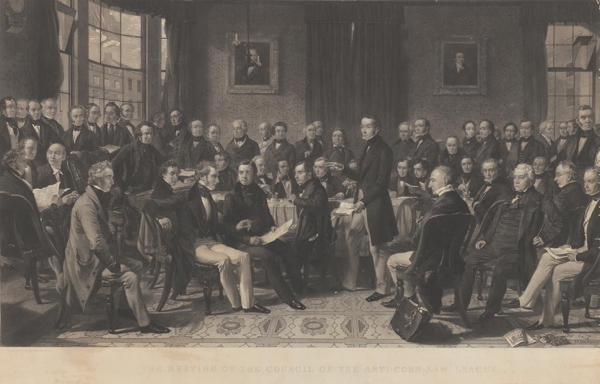 |
 |
|
This picture has no date. Cobden is naturally "no.1" standing in the centre of the picture. The members of the executive are obviously repectable businessmen (from their attire), with no women executive members, and nobody is dressed like an ordinary worker. The ACLL did have a broader range of activists who were members, such as organisers of meetings, fundraisers, and itinernat lecturers.
|
Means of Propaganda
|
Illustration 11: Membership Cards for the National ACLL↩ |
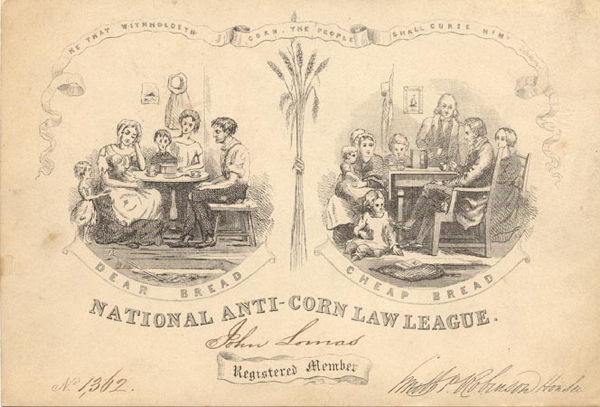 |
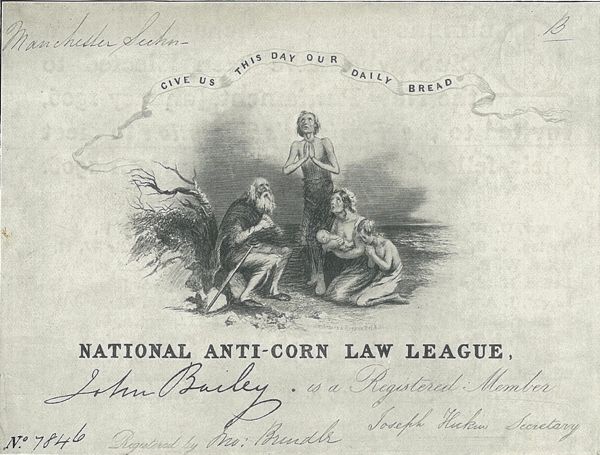 |
|
Two examples of Membership Cards for the National Anti-Corn Law League: |
|
Illustration 12: ACLL Badge or Button↩ |
Illustration 13: ACLL Medallion↩ |
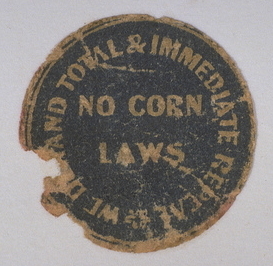 |
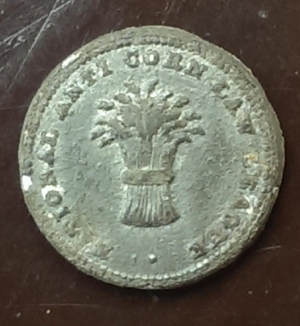 |
|
A button or badge which is probably made of wood or cardboard and which states: "No Corn Laws. We demand Total & Immediate Repeal." The call for immediate and total abolition was a deliberate strategic decision rather than agitiating for partial reform.
|
Medallion of the National Anti-Corn Law League. The symbol of the sheaf of wheat was commonly used by the ACLL in its propaganda.
|
Key Texts
|
Illustration 14: TP of Elliott, the "Corn-Law Rhymer"↩ |
Illustration 15: TP of Perronet Thompson's Corn-Law Fallacies↩ |
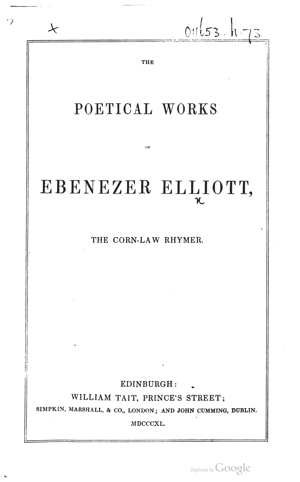 |
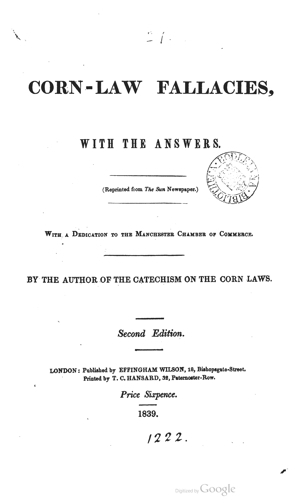 |
|
Elliott's books sold surprisingly well for poems and stories about economic policy. This compilation was published in 1840 and inlcudes some of his "hymns" to free trade [see below for an example.]
|
Thompson was a very witty and knowledgeable writer as well as a gifted orator who was much used on the ACLL lecture circuit. He took the popularization of economic ideas, pioneered by Jane Marcet and Harriet Martineau in the 1820s and 1830s, to a new and higher level with his dialogues and catechisms. He was known to Bastiat and may well have inspired him to do much the same.
|
|
Illustration 16: A mass produced copy of one of Cobden's Speeches in the House↩ |
Illustration 17: TP of a presentation copy of key ACLL literature↩ |
 |
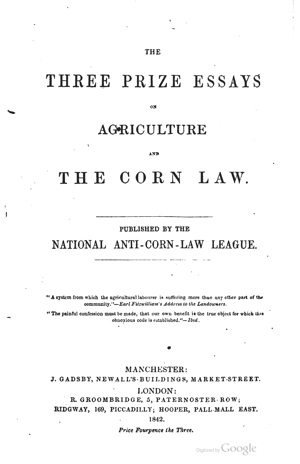 |
|
Title page of a mass distribution copy of a speech given by Cobden in the House of Commons on Feb. 24, 1842. Note that it cost 1 penny and that 16,000 had been printed. This was part of the ACLL's strategy to diseminate their views as widely as possibl in both visual and print formats.
|
This is from a 1842 edition of a selection of ACLL material which was bound in a special presentation edition designed to be signed and given away to potential supporters. It cost only 4 pence, was embossed with a gold image on the cover [see below], had a presentation page where the recipient's name could be hand written, and contained a selection of key ACLL material. The ACLL also awarded money prizes in essay competitions designed to stimulate interest in the topic of free trade. Tis volume contains three of those prize-winning essays.
|
|
Illustration 18: First page of Peronnet Thompson's Catechism↩ |
Illustration 19: First page of a dialogue between a Gentleman and a Farmer↩ |
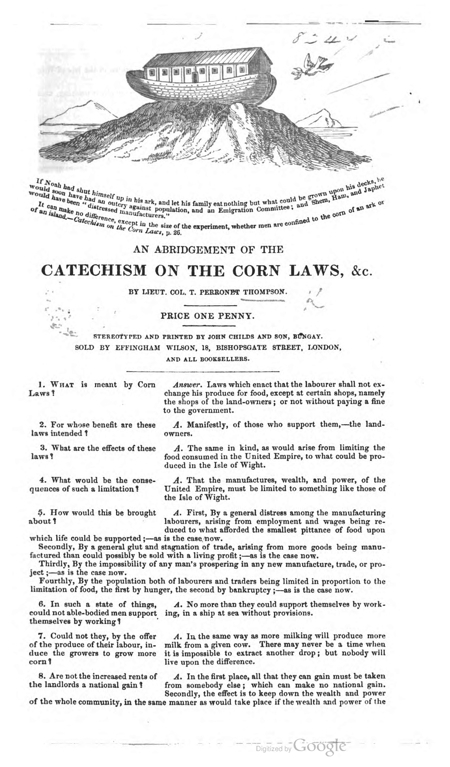 |
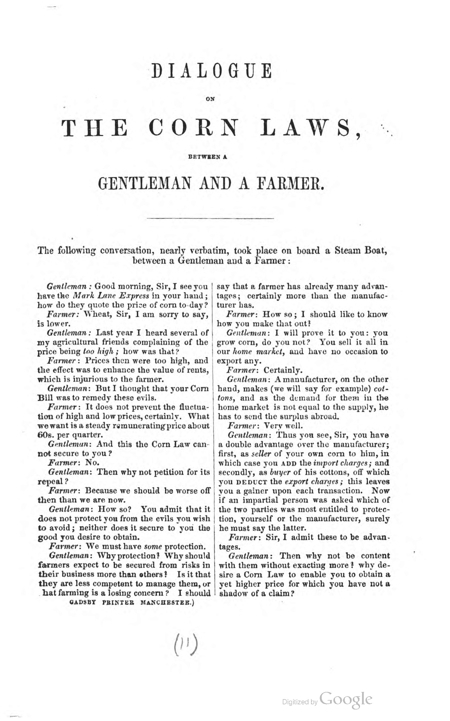 |
|
This is the first page of Perronet Thompson's "Catechism" of question and response about free trade and protection. It was designed to appeal to religiously-minded readers and gave them easy to understand answers to FAQs. It cost 1 penny and, as was typical, there is an amusing illustration which accompanies the text. It mocks the idea that Noah migh have been a protectionist. Noah's ark is resting on top of Mount Arafat and the caption states: "If Noah had shut up his ark, and let his family eat nothing but what could be grown upon his decks, he would soon have had an outcry against population, and an Emigration Committee; and Seth, Ham, and Japhet would have been "distressed manufacturers." It can make no difference except in the size of the experiment, whether men are confined to the corn of an ark or of an island. - Catechism on the Corn Laws. p. 26." It would have been even funnier if the dove had been carrying a sheaf of wheat in its beak, thus making it a free trading importer of foreign wheat.
|
Like the best-selling "conversations" created by Jane Marcet and Harriet Martineau, we have a constructed conversation between a "Gentleman" and a "Farmer" in which free trade economic ideas are discussed as they might be in the street, the pub, or as here, on a boat. The Gentleman supports the repeal of the corn laws; the Farmer what to retain its price supports and bans on cheap imports. The master of this technique was Bastiat who invented sophisticated "Crusoe economics" where Robinson Crusoe and Friday debate econimic ideas such as protectionism. Bastiat's amusing conceipt was to have protectionism ideas advocated by the sophisticated European Robinson and free trade ideas by the primitive "native" Friday.
|
|
Illustration 20: Some of Elliott's "Corn-Law Hymns"↩ |
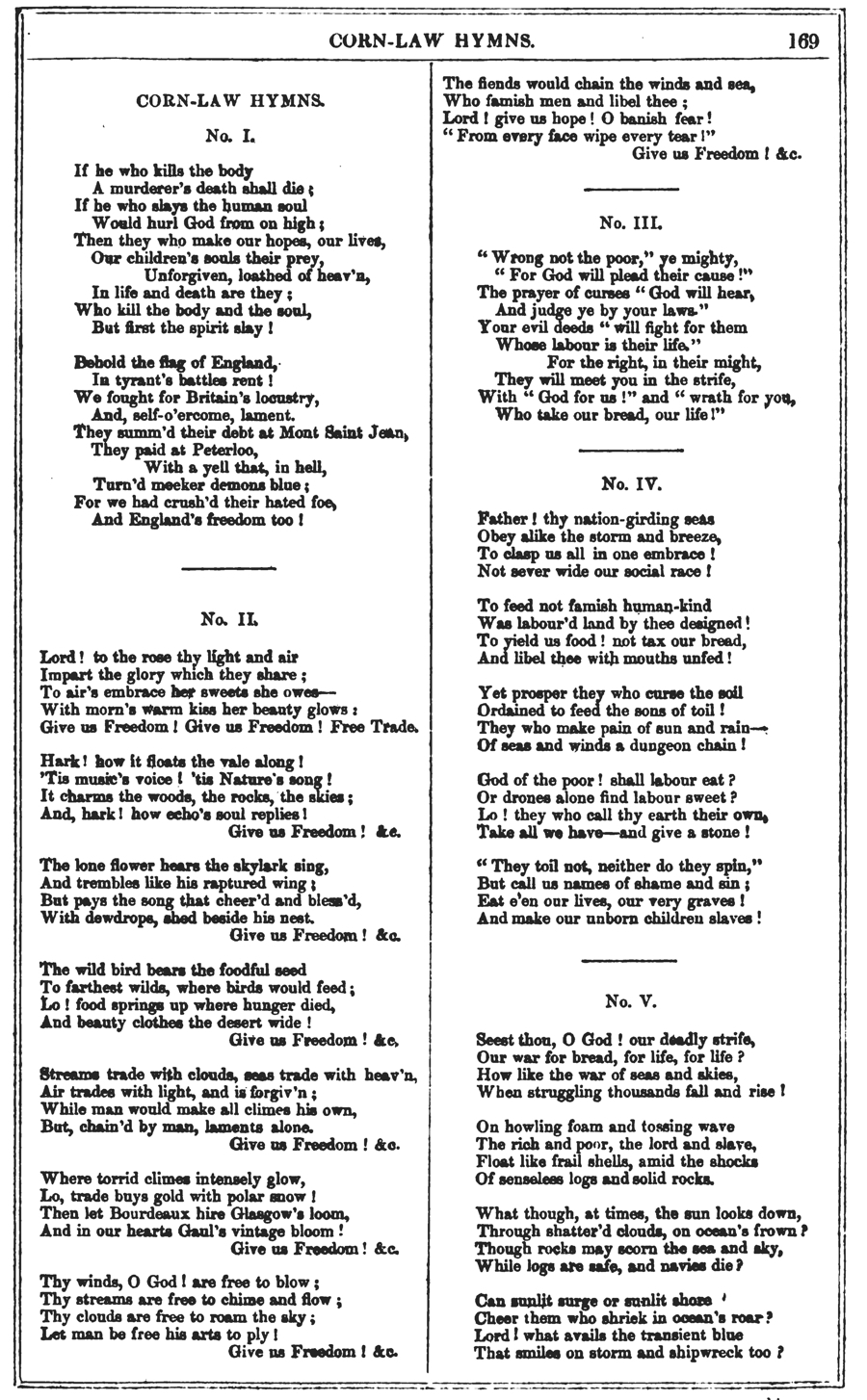 |
|
This page of "hymns" comes from Ebenezer Elliott's Poetical Works (1840).
|
|
Illustration 21: Embossed cover of the ACLL Presentation copy of key literature↩ |
Illustration 22: Page where the recipient's name can be written↩ |
 |
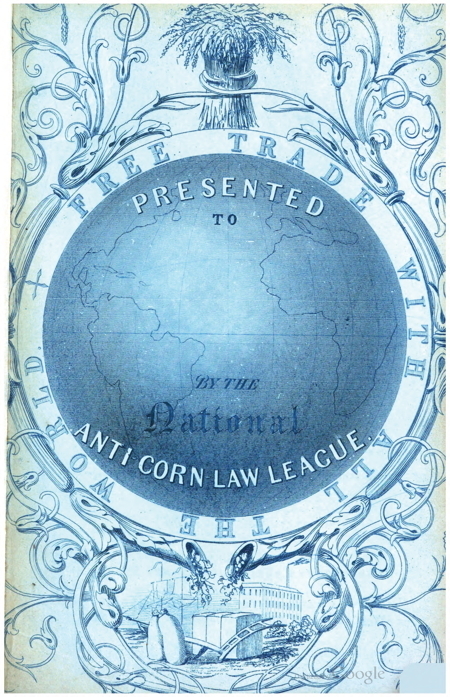 |
|
The gold embossed leather cover of The Three Prize Essays on Agriculture and the Corn Law (and other writings) (Manchester: J. Gadsby, 1842). The first prize was 20 guineas, 2nd prize 10 guineas, 3rd prize 5 guineas. The first half of the book (118 pp.) contained the three prize winning essays with the rest being made up of a selection of other ACLL literature. [See below for a more detailed image of the cover illustration.]
|
The collection of essays was designed to be given away to prospective supporters in large numbers (4 pence). Inside the cover one could inscribe the copy to a particular person. The accompanying illustation has a globe surrounded by the motto "Free Trade with All the World." There is a sheaf of wheat at the top; 2 cornucopias at the bottom above a picture of a factory, a ship, and sacks of wheat and a plough.
|
|
Illustration 23: More detailed image of embossed cover↩ |
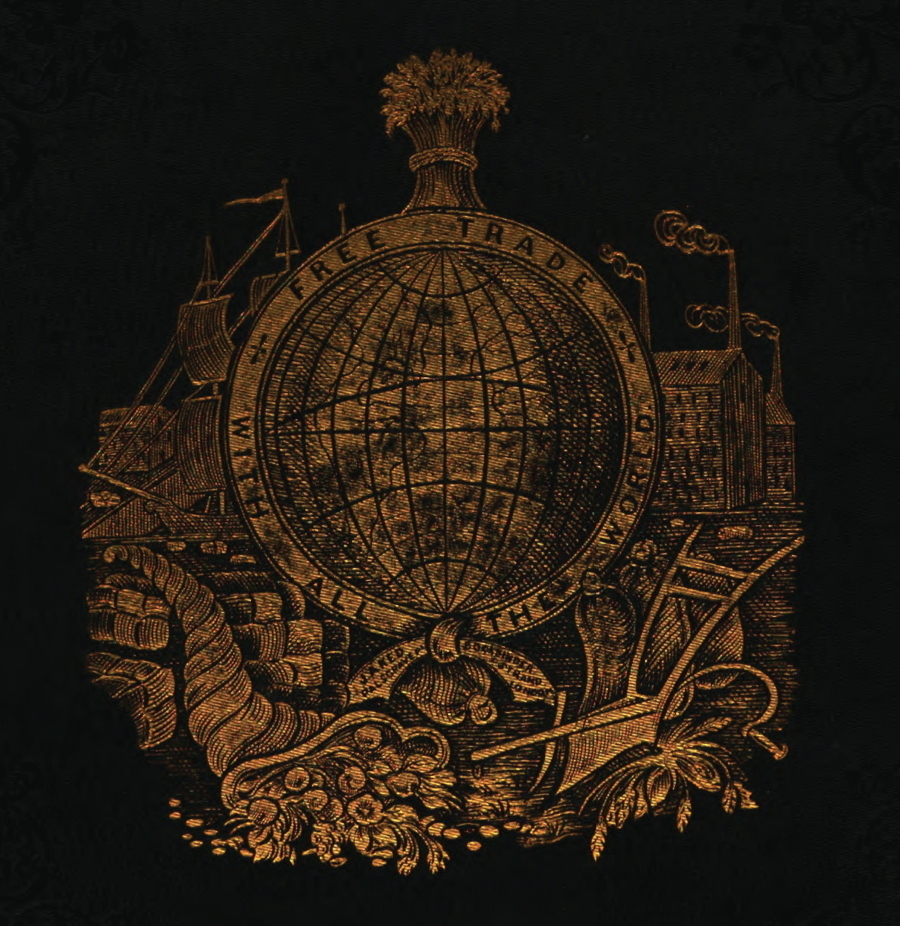 |
|
The gold embossed cover is a more elaborate depiction of the image on the inside presentation page: a wheat sheaf stands atop the globe which is circumscribed by the motto "Free Trade with All the World." On the left of the globe is a ship; on the right a factory; below there are bales of goods for the ship; bags of wheat, and a plough, and a large cornucopia. [the inscription on the bow at the bottom of the motto is illegible.]
|
|
Illustration 24: Illustrated ACLL envelope with accompanying poem by Horatio Smith↩ |
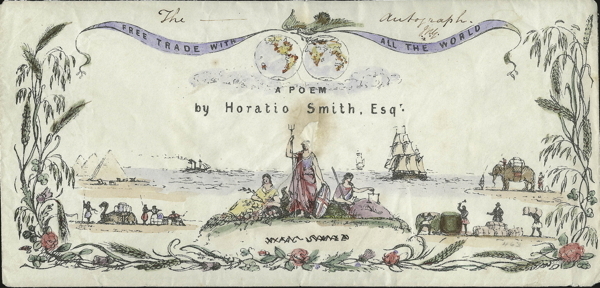 |
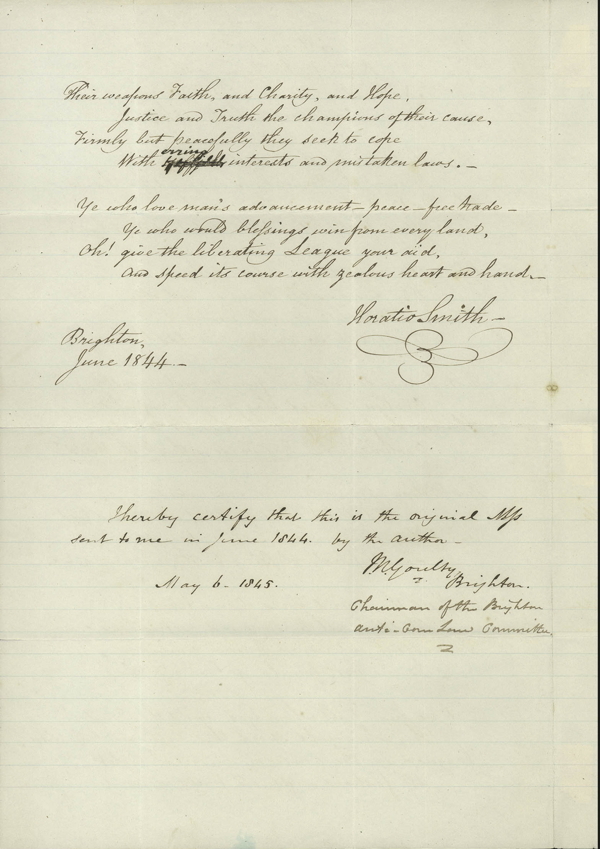 |
|
Envelopes for letters with ACLL designs on them seemed to have been very popular given the number of different kinds which exist. Cobden and other liberals had also campaigned for a cheaper and more efficient postal system in the late 1830s with the aim that the lower cost of communication would considerably assist business activity. A "Uniform Penny Post" was introduced in January 1840 which the ACLL immediately used to circulate their free trade literature. This dramatic drop in the cost of sending letters anywhere within the UK may explain why these ACLL designed envelopes were so popular. [See below for more examples.] Horace (Horatio) Smith (1779-1849) was a poet, novelist, and successful stockbroker who became famous for his parodies of other English poets. The poem goes as follows: Their weapons Faith, and Charity, and Hope, Ye who love man's advancement - peace - free trade Horatio Smith |
|
Illustration 25: A Song calling for the "Abolition of the Corn Laws"↩ |
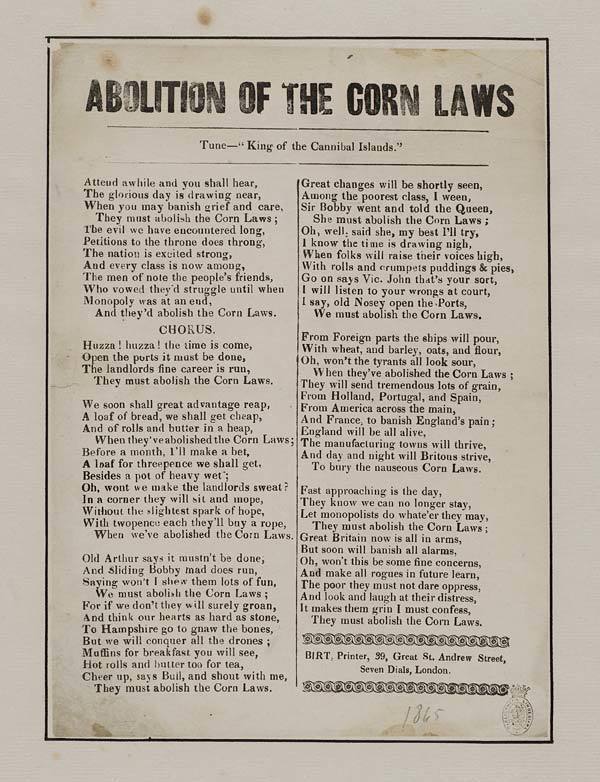 |
|
Unknown author; unknown tune, dated by library 1845. First verse and chorus: Attend a while and you shall hear, CHORUS |
|
Illustration 26: A large public meeting of the ACLL held at Exeter Hall, London (1846)↩ |
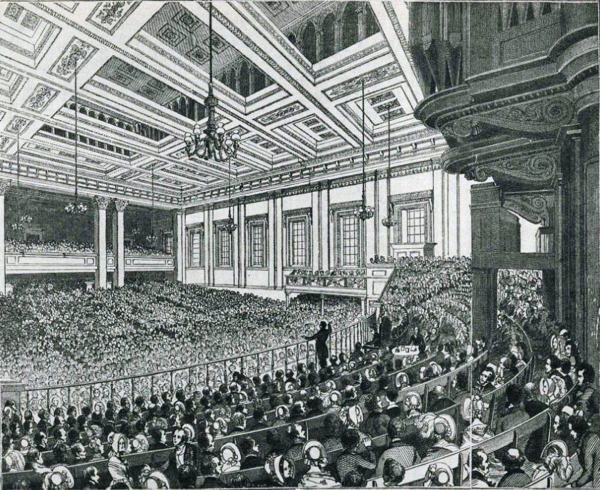 |
|
Exeter Hall was a hall on The Strand in London built between 1829 and 1831. The smaller hall's auditorium could hold around 1,000 people, and the main hall's auditorium could hold more than 4,000 people. It was often used by reform groups for the public meetings, such as the Protestant Reformation Society and the Anti-Slavery Society. This image shows a meeting of the ACLL in early 1846. it is possible that nearly 4,000 people were present.
|
|
Illustration 27: A Poster urging People to "Register" their Names on a Petition to Parliament↩ |
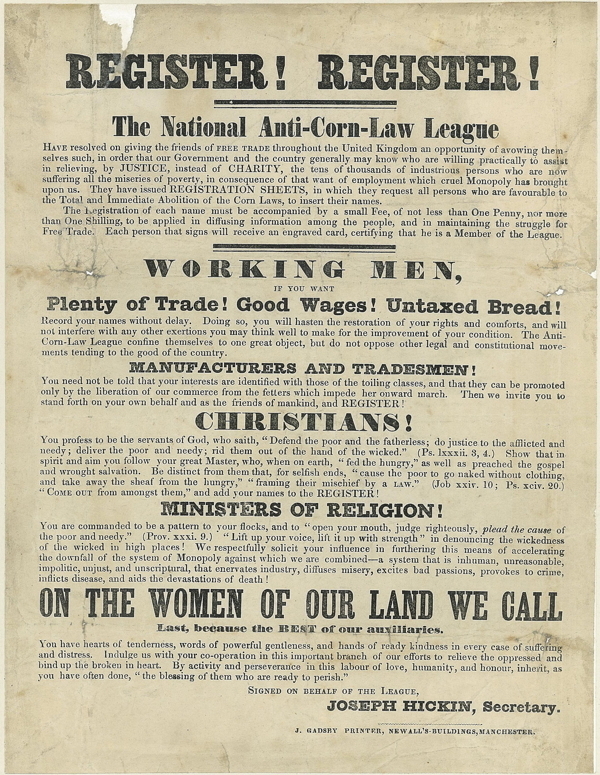 |
|
The ACLL used petition drives to get lists of signatures of those who supported "the Total and Immediate Abolition of the Corn Laws" to present to Parliament in order to put pressure on politicians. They were not the first to use this tactic to bring pressure on the government as the Anti-Slavery Society had done the same 40 years earlier. What had changed since then was the expansion of the vote to include much of the middle class in the Reform Act of 1832 which meant that many more of the names on the petition drives could actually vote and perhaps threaten the survival of any given politician. Note that women were listed "last, because (they are) the BEST of our auxiliaries."
|
Fundraising with Bazaars and Tea Parties
|
Illustration 28: Advertisement for an ACLL fundraising Bazaar in Manchester↩ |
Illustration 29: A china figurine of Cobden↩ |
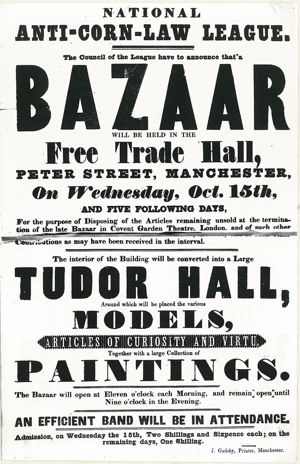 |
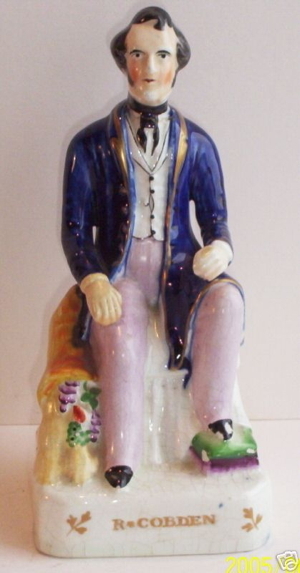 |
|
A poster advertising an ACLL Bazaar to be held at Free rade Hall in Manchester on Oct. 15, 1844??. Supporters would donate goods which would be sold to make money for the ACLL. The League also had their own merchandise for sale such as buttons, badges, envelopes, books, and perhaps even china wear like plates and figurines.
|
A china figurine of Richard Cobden.
|
|
Illustration 30: Illustration of an ACLL Bazaar (with a cartoon from Punch)↩ |
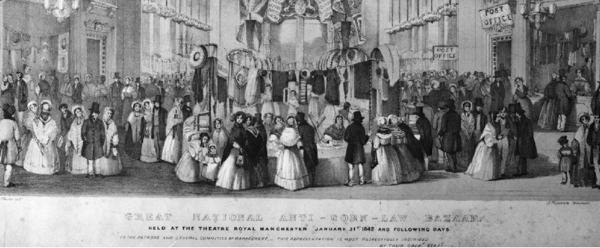 |
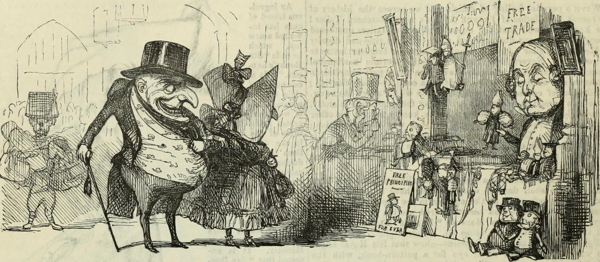 |
|
The "Great National Anti-Corn LawBazaar held at the Theatre Royal in Manchester, Jan. 31, 1842. Note the central table with banners, the family groups wandering around, some people are reading books or pamphlets, and the proximity of the Post Office on the right to send friends ACLL designed letter envelopes. Below is a cartoon from the satirical magazine Punch which makes fun of the ACLL merchandise such as dolls and figurines.
|
|
Illustration 31: An Invitation to an ACLL "Tea Party"↩ |
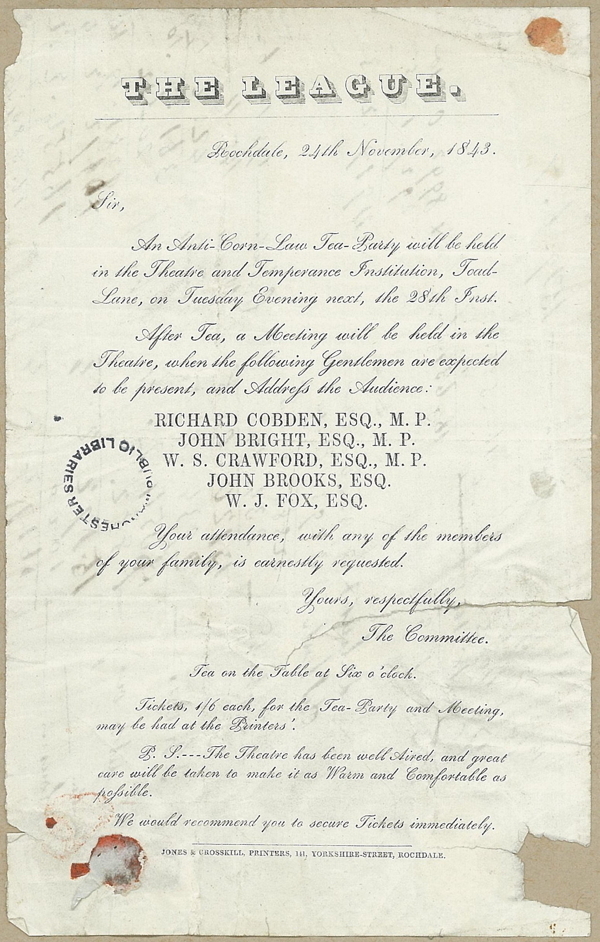 |
|
Perhaps the ACLL is the original "Tea Party" movement? Here is an invitation to a formal Tea Party for 6 p.m. 28 Nov. 1843 at Toad Lane, Rochdale (which Cobden represented in Pariament). After Tea the patrons could enjoy a Meeting at which both Cobden and Bright would speak. Note that potential guests are assured that the hall has been "well aired" and would be heated.
|
ACLL Merchandizing: Envelopes, Figurines
|
Illustration 32: Illustrated envelopes with ACLL imagery↩ |
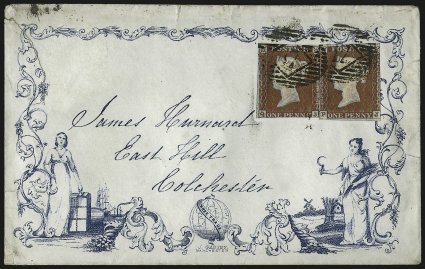 |
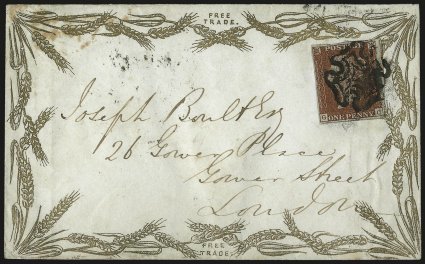 |
|
These are two examples of elaborately illustrated envelopes which supporters of free trade could purchase to both take advantage of the new penny post and make their political views known to the recipient of their mail.
Above: At the bottom centre is a globe with a sash on which is written "Free Trade". To the left is a female figure pointing to some cargo which will be soon loaded onto the ship behind her; to the right is another female figure who is holding a hand scythe used to harvest grain, behind her is a field with a wheat sheaf and a windmill. Below: This is a simpler design with ears of wheat forming a border around the envelope. At the top and bottom centre are the words "Free Trade." See also Illustration 29 of the china figurine of Cobden (above). |
Political Success: Repeal in 1846, Free Trade Treaty in 1860
|
Illustration 33: PM Sir Robert Peel↩ |
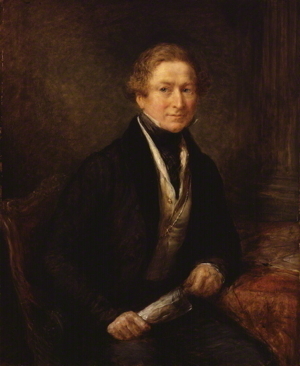 |
|
Sir Robert Peel (1788–1850) was a Conservative politician and wealthy textile manufacturer who was Prime Minister between August 1841 and June 1846. He was influential in getting the Repeal of the Corn Laws passed against much opposition from within his own party (he was forced resign soon after the Repeal passed).
|
|
Illustration 34: Cartoon of Peel "confessing his sins" to Cobden↩ |
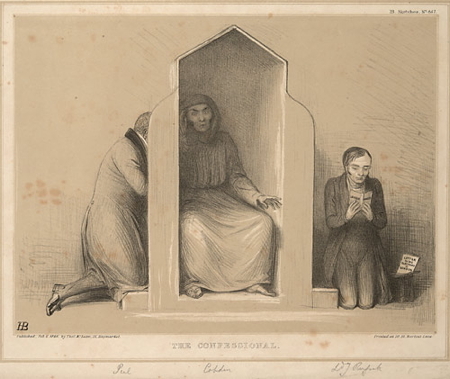 |
|
John Doyle ("H.B."), "The Confessional" (c. 1846) |
The Prime Minister Sir Robert Peel introduced for a third and final reading before the House of Commons the Bill of Repeal (Importation Act 1846) on 15 May 1846 which was passed by 327 votes to 229 (a majority of 98). [Importation Act 1846 (9 & 10 Vict. c. 22)]. It became law when the House of Lords voted for it on 25 June. The following are extracts from Peel's speeches and Mr. Villiers' closing remarks before the vote was taken:
Extracts from Peel's speeches:
Sir, I believe it is now nearly three months since I first proposed, as the organ of Her Majesty's Government, the measure which, I trust, is about to receive to-night the sanction of the House of Commons; and, considering the lapse of time—considering the frequent discussions—considering the anxiety of the people of this country that these debates should be brought to a close ...
Sir, I have explained more than once what were the circumstances under which I felt it my duty to take this course. I did feel in November last that there was just cause for apprehension of scarcity and famine in Ireland. I am stating what were the apprehensions I felt at that time, what were the motives from which I acted; and those apprehensions, though they may be denied now, were at least shared then by those hon. Gentlemen who sit below the gangway (the protectionists). The hon. Member for Somersetshire expressly declared that at the period to which I referred he was prepared to acquiesce in the suspension of the Corn Laws. An hon. Member also, a recent addition to this House, who spoke with great ability the other night, the hon. Member for Dorsetshire (Mr. Seymer) distinctly declared that he thought I should have abandoned my duty if I had not advised that, considering the circumstances of Ireland, the restrictions on the importation of foreign corn should be temporarily removed. I may have been wrong, but my impression was, first, that my duty towards a country threatened with famine required that that which had been the ordinary remedy under all similar circumstances should be resorted to—namely, that there should be free access to the food of man from whatever quarter it might come. ...
Sir, I do not rest my support of this Bill merely upon the temporary ground of scarcity in Ireland. I do not rest my support of the Bill upon that temporary scarcity; but I believe that scarcity left no alternative to us but to undertake the consideration of this question; and that consideration being necessary, I think that a permanent adjustment of the question is not only imperative, but the best policy for all concerned. And I repeat now that I have a firm belief that it is for the general benefit of all—for the best interests of the country, independent of the obligation imposed on us by temporary scarcity, it is for the general interests of the great body of the people that an arrangement should be made for a permanent removal of the restrictions upon the introduction of food.
A passage from the concluding speech by Mr. Villiers before the vote was taken:
... now he asked those hon. Gentlemen opposite to pause before they proclaimed themselves to the country, and transmitted their names to posterity, as having to the last endeavoured to withhold from the people the unquestionable right, the undoubted privilege and great advantage, of carrying the fruits of their industry to the highest market, and of allowing them the freest access to the bounties which Providence, through the industry of other nations, had provided for them. Let them reflect before they vote, that the law of which they are so tenacious has been discredited by all experience, denounced by every intelligent authority, and has, upon facts undisputed, because they are indisputable, been shown to have brought upon the poorest of our fellow creatures as much misery, affliction, destitution, and crime as was ever produced by any pestilence or calamity with which the country was visited. Let them pause then, he said, before they offer to the country and posterity no other or better testimony of their efforts in public life than that of endeavouring to withhold from them a great advantage, and to perpetuate on the poor an enormous wrong.
Source Hansard: HC Deb 15 May 1846 vol 86 cc616-727. Online at <http://hansard.millbanksystems.com/commons/1846/may/15/corn-importation-bill-adjourned-debate>.
The Cobden-Chevalier Trade Treaty of 1860
|
Illustration 35: Bright, Cobden, Chevalier in 1860 for the signing of the Anglo-French Trade Treaty↩ |
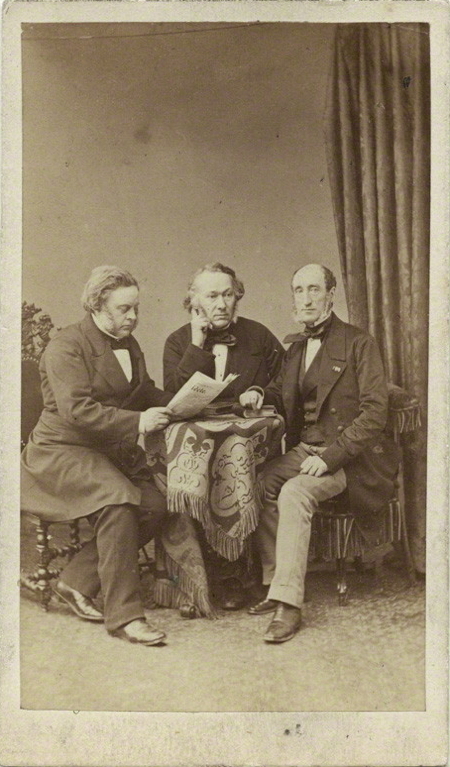 |
|
The Anglo-French Trade Treaty of 1860 (also known as the Cobden-Chevalier Treaty) was one of the most important trade treaties of the 19th century. It cemented low tariffs for trade between the two leading economies of western Europe and established a number of principles which were adopted by other nations in their bi-lateral trade treaties (such as the "most favoured nation" clause which applied the lowest tariff which was agreed with one nation to be applied to another nations automatically). Cobden was appointed by the British government to sign the Treaty on its behalf; Michel Chevalier (1806-87) was a liberal economist and a Minister under Napoleon III. Initially he was a Saint-Simonian socialist but was converted to the free trade cause. He was appointed to the chair of political economy at the Collège de France in 1840.
|
|
Illustration 36: Page 1 of the Treaty↩ |
Illustration 37: Page 2 of the Treaty↩ |
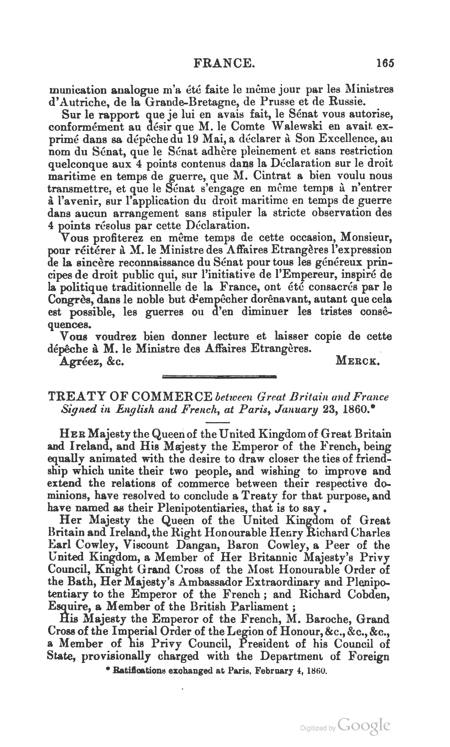 |
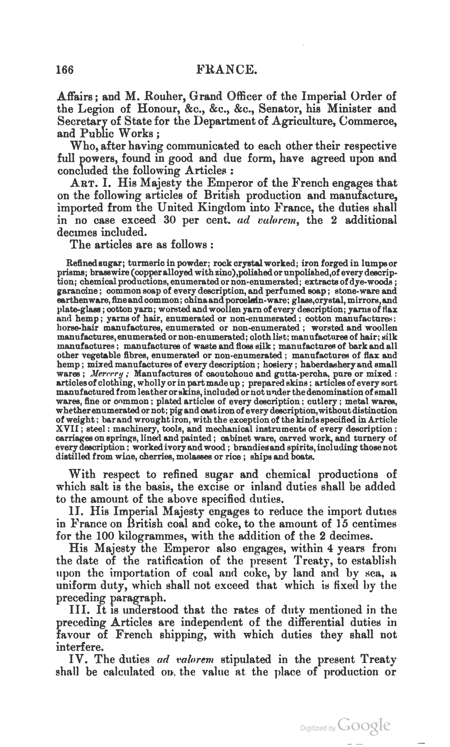 |
|
From: A Complete Collection of the Treaties and Conventions, and Reciprocal Regulations at Present Subsisting Between Great Britain and Foreign Powers, ed. Lewis Hertslet (H.M. Stationery Office, 1864). Vol. 11.
|
|
38. Satirizing Cobden and Bright: Daumier
The Treaty of Paris of 1856 concluded the Crimean War (1854-56) between Russia and an alliance of the Ottoman Empire, the British Empire, Second French Empire, and the Kingdom of Sardinia. The treaty was signed on 30 March 1856 at the Congress of Paris. While the Congress was in progress the French satirist Honoré Daumier made fun of Richard Cobden and John Bright who were the leading advocates for peace and free trade in England. Cobden lost his seat in Parliament in 1857 because of his opposition to the War; Bright held his seat but was one of the very few peace MPs in the chamber. Daumier depicted Cobden as tall and lanky and had him wear load checked or tartan trousers and a hat. Bright was short and dumpy and often wore the black broad-brimmed hat of the Quakers (Bright was Quaker).
|
Daumier 1: Song of Jubilation (11 Feb. 1856)↩ |
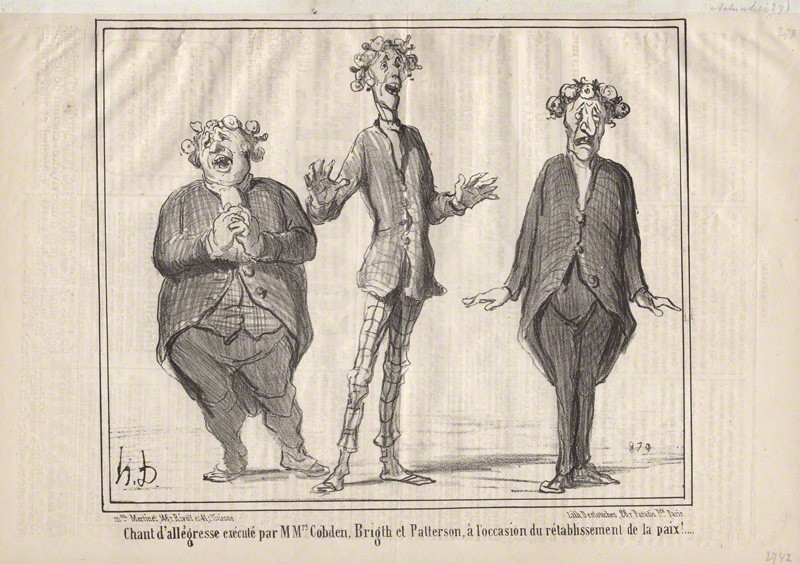 |
|
John Bright; Richard Cobden; Mr Patterson, published 11 February 1856 - "Song of Jubilation sung by Mess. Cobden, Bright, and Patterson on the Occasion of the Re-establishment of Peace."
|
|
Daumier 2: The Return of the Golden Age (12 Feb. 1856)↩ |
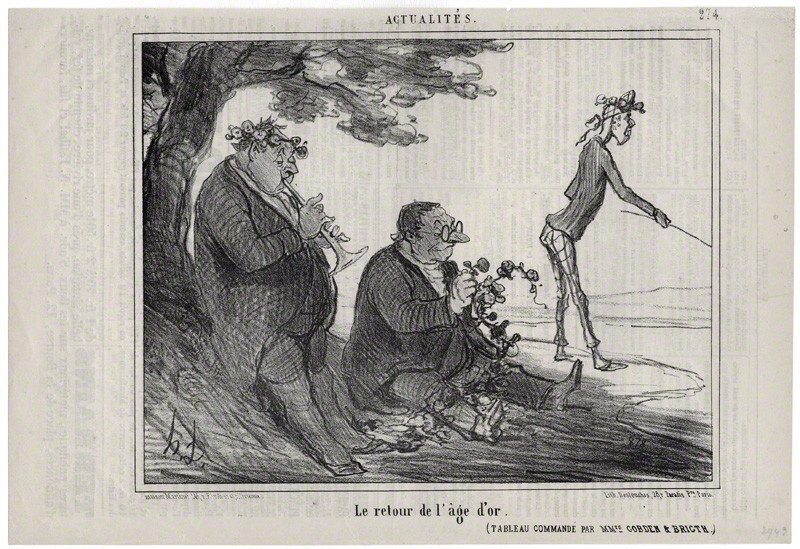 |
|
Bright, unknown person, and Cobden, published 12 February 1856 - "The Return of the Golden Age."
|
|
Daumier 3: Triumphal March (25 Feb. 1856)↩ |
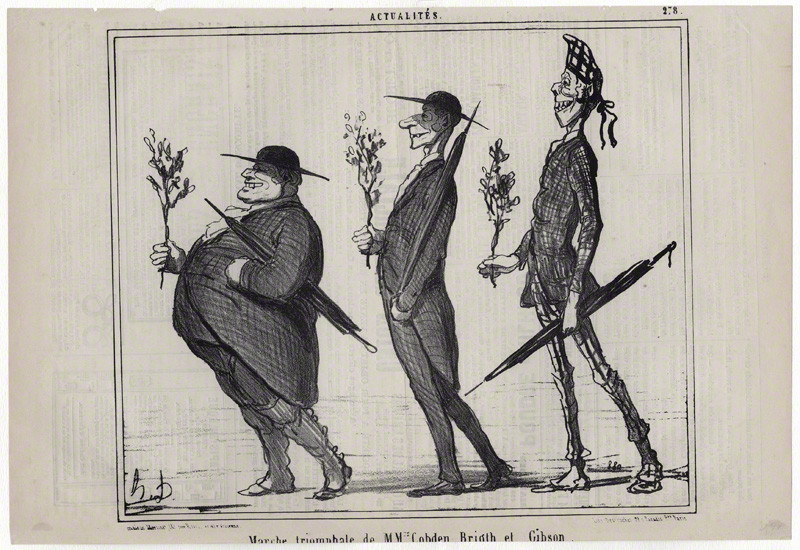 |
|
John Bright; Thomas Milner Gibson; Richard Cobden, published 25 February 1856 - "The Triumphal March of Mess. Cobden, Bright, and Gibson."
|
|
Daumier 4: Cobden's Anger (9 April, 1856)↩ |
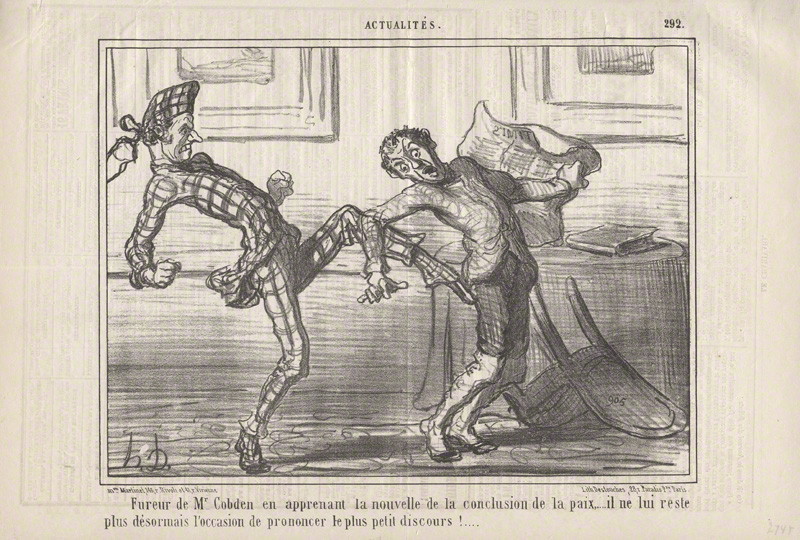 |
|
Richard Cobden and unknown person, published 9 April 1856"Mr. Cobden's anger at learning the news of the conclusion of the Peace Conference ... there no longer is any opportunity for him to give his little speeches!"
|
|
Daumier 5: Cobden, Bright and Gladstone only moderately happy (14 Apr. 1856)↩ |
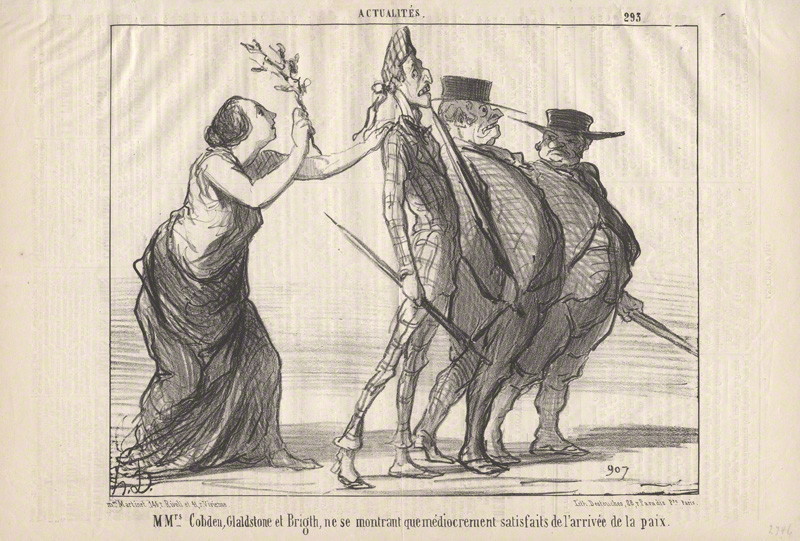 |
|
The figure of peace, Richard Cobden; William Ewart Gladstone; John Bright, published 14 April 1856 - " Mess. Cobden, Gladstone, and Bright showing themselves to be only moderately satisfied with the arrival of Peace?
|
|
Daumier 6: Cobden, Bright, and Sturges have too much leisure (18 Apr. 1856)↩ |
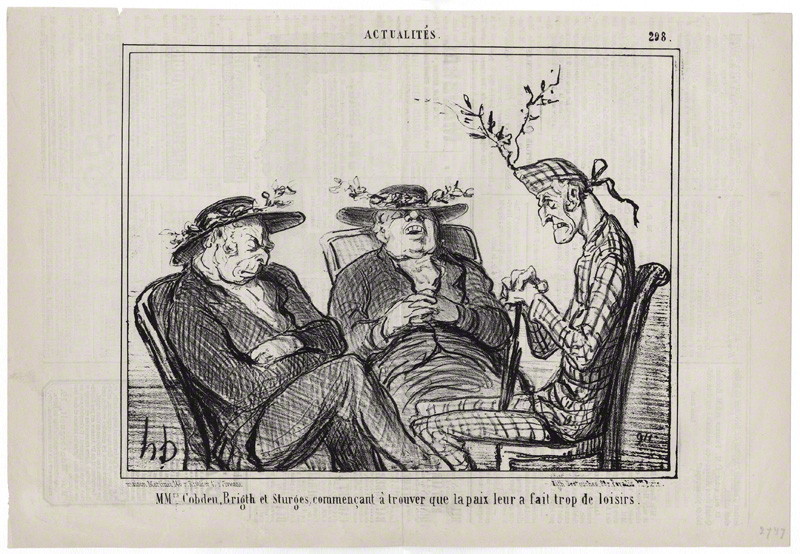 |
|
Joseph Sturge; John Bright; Richard Cobden, published 18 April 1856 - "Mess. Cobden, Bright, and Sturges are starting to realise taht peace has given them too much leisure"
|
|
Daumier 7: Cobden, Bright, and Sturges no longer having anything to do in Europe (19 Apr. 1856)↩ |
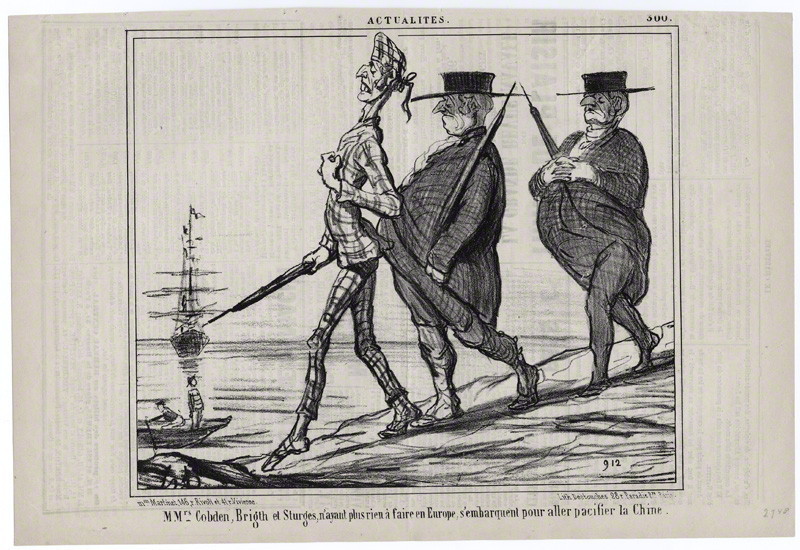 |
|
Richard Cobden; Joseph Sturge; John Bright, published 19 April 1856 - "Mess. Cobden, Bright, and Sturges no longer having anything to do in Europe, set sail to pacify China."
|
|
Daumier 8: Cobden finding things to do in Peace time (23 Apr. 1856)↩ |
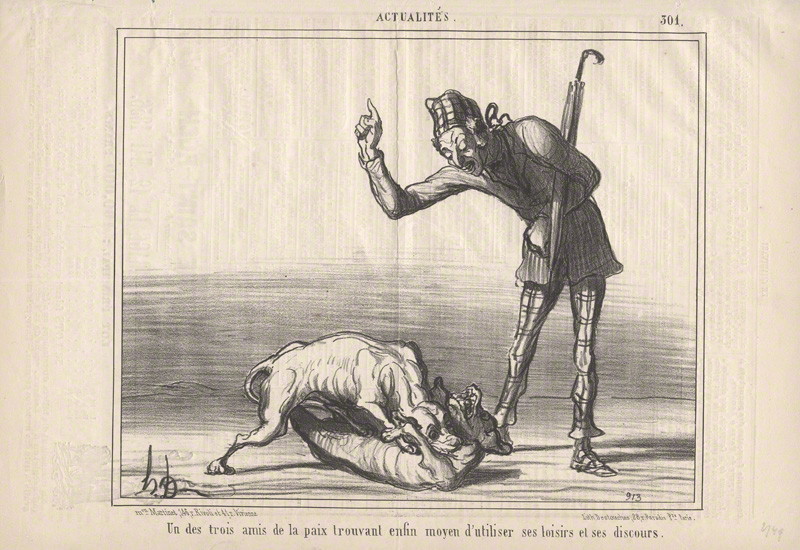 |
|
Two fighting dogs, Richard Cobden, published 23 April 1856 - "One of the three friends of peace is finding at last one way of using his leisure and his speaking skills"
|
|
Daumier 9: The Three Friends of Peace wage War (28 Apr. 1856)↩ |
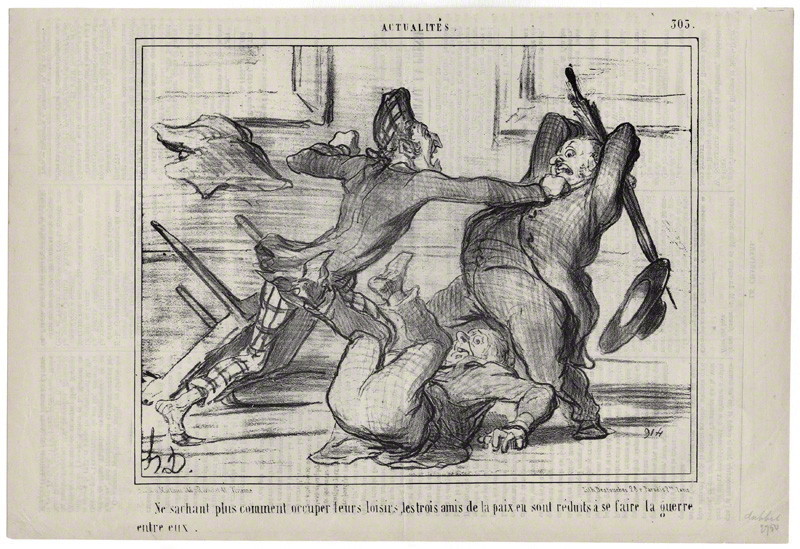 |
|
Richard Cobden; Joseph Sturge; John Bright, published 28 April 1856 - "No longer knowing what to do in their leisure time, the three friends of peace are reduced to waging war (among themselves)"
|
Continuing the Struggle: The Cobden Club, Jane Cobden
Cobden died in 1865. His friend Thomas Bayley Potter founded The Cobden Club in his honour in 1866 in order to continue to promote the ideals of "Peace, Free Trade and Goodwill Among Nations". The first meeting of the club was held at the Reform Club in London on 15 May 1866 and the first club dinner meeting was held on 21 July 1866 at the Star and Garter Hotel in Richmond which was presided over by William Ewart Gladstone (1809-1898) who would serve as Prime Minister in 1868–74. During the late 19th cenury and early 20th century the Cobden Club published a series of books and pamphlets defending the principles of free trade as the tide was turning against it throuhgout Europe.
Cobden's daughter Jane (1851-1947) (later Unwin when she married the liberal publisher Thomas Fisher Unwin (1848 - 1935) became active in liberal politics in her own right with activity promoting women's suffrage, land reform ("free trade in land"), Irish independence, opposition to the Boer War in South Africa (1899-1902).
|
Illustration 39: The Second Series of Cobden Club Essays (1871-72)↩ |
Illustration 40: Cobden Club edition of Bastiat's Economic Sophisms (1909)↩ |
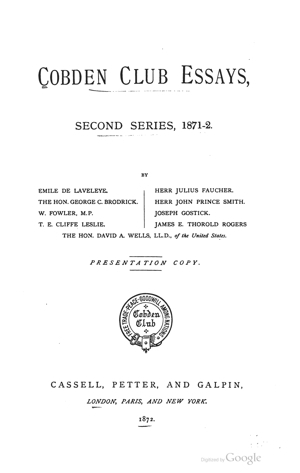 |
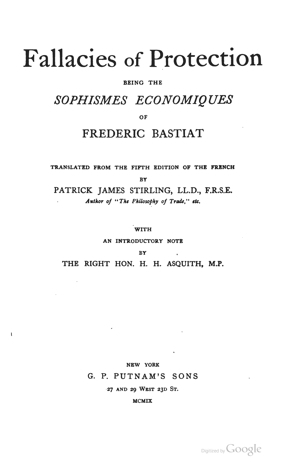 |
|
Many of the speeches given at Cobden Club dinners were published as pamphlets or in collections like this one from 1871-72.
|
The Cobden Club also published translations like this collection of "economic sophisms" by the great French free trader Frédéric Bastiat (1801-1850).
|
|
Illustration 41: Jane Cobden (1851-1947)↩ |
Illustration 42: Campaign Poster for the London County Council Election 1889↩ |
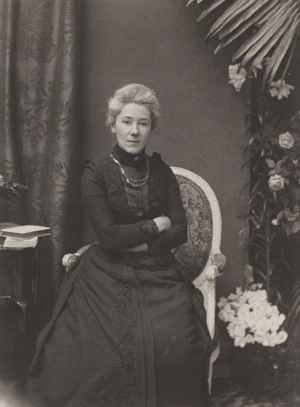 |
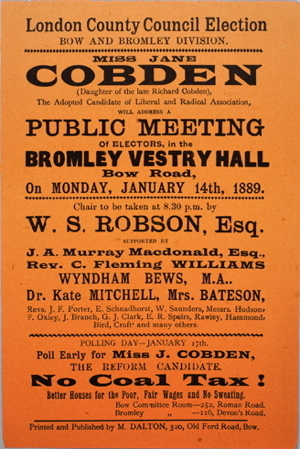 |
|
|
Jane Cobden stood for election to the London County Council in 1889 on a platform against the tax on coal, better housing for the poor, "fair" wages," and no "sweating:" (sweat shops). Although women could vote in County elections they could not serve if elected. Cobden was elected and took her seat which was challenged in court and she was fined.
|
|
Illustration 43: TP of "Land Hunger" (1913)↩ |
Illustration 44: TP of "The Hungry Forties" (1904)↩ |
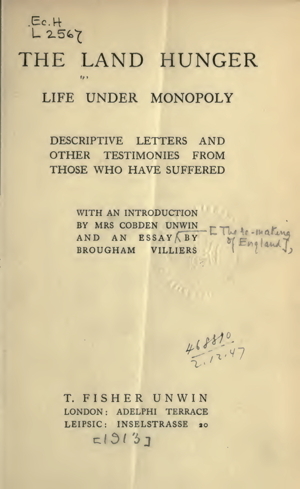 |
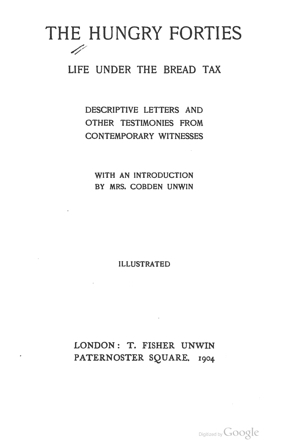 |
|
The TP of her book demanding broader land ownership in England, or what she called "free trade in land".
|
To help keep her father's name and free trade cause alive Jane published this book which was part history of the free trade movement in the 1840s. She included a number of illustrations and facsimiles which shed light on the activities of the ACLL. [See below for details.]
|
|
Illustration 45: Page 1 from a Letter from Cobden republished in Jane's The Hungry Forties (1904) showing him working on ACLL designs for anti-protectionist imagery↩ |
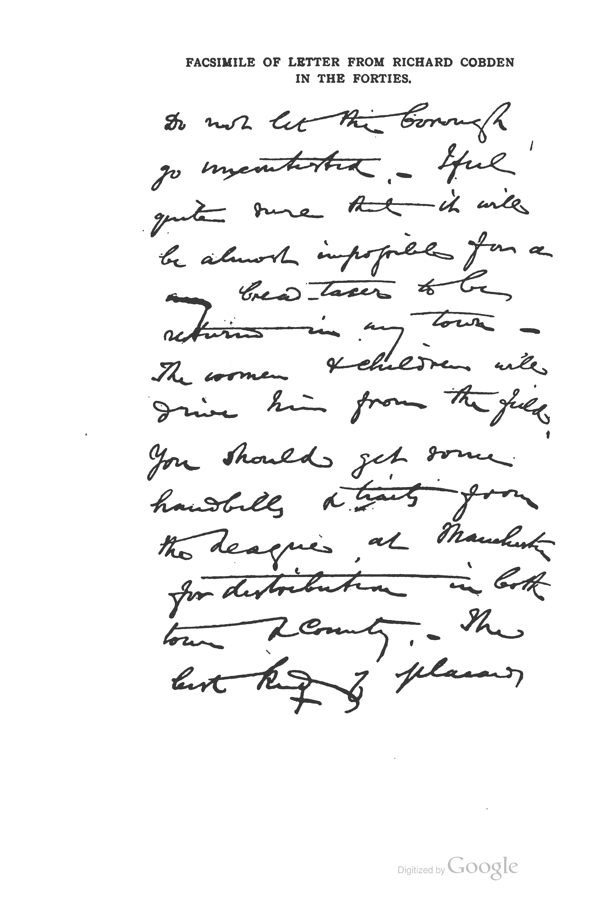 |
|
|
|
Illustration 46: Page 2 from a Letter from Cobden republished in Jane's The Hungry Forties (1904) showing him working on ACLL designs for anti-protectionist imagery↩ |
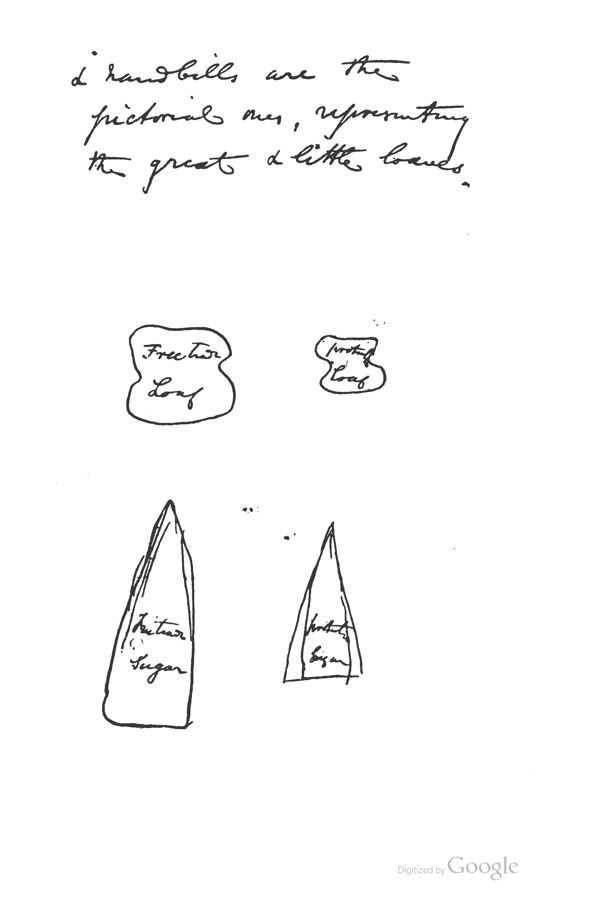 |
|
Richard Cobden's sketches for images of loaves of bread and sugar cones to show how free trade provides bigger ones and protection smaller ones. Possibly drawn to be used in ACLL propaganda.
|
|
Illustration 47: Frontispiece showing the "Fairy Wheatsheaf"↩ |
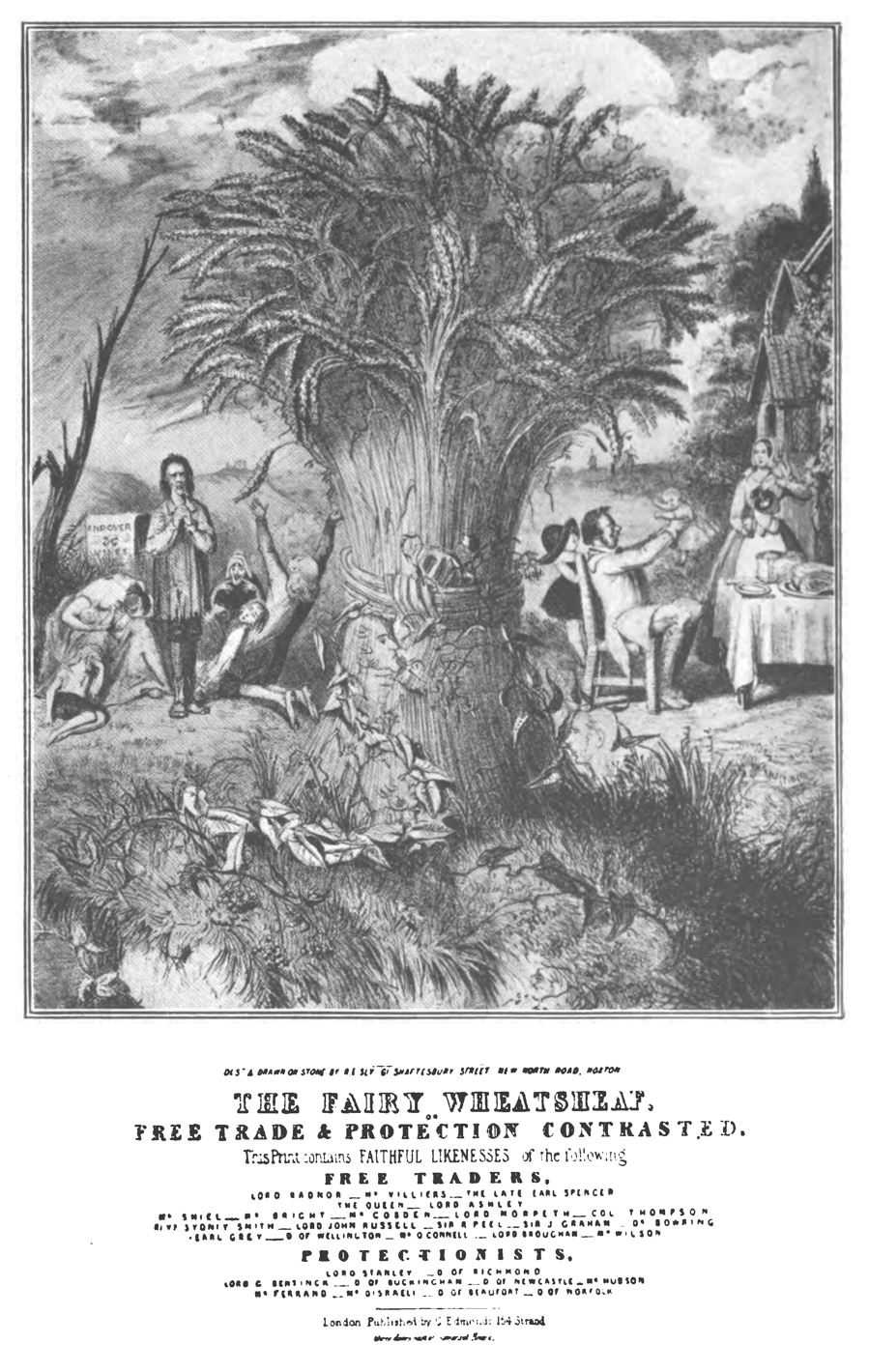 |
|
An elaborate allegorical illustration used as the frontispiece in Jane Cobden's book The Hungry Forties (1904) which was part of the free trade campaign against Joseph Chamberlain's pro-tariff movement in 1903. There is a very large sheaf of wheat (the "Fairy Wheatsheaf") in the centre with the heads of Cobden and Bright near the base (other heads are visible in the grass beneath and around the sheaf but this are hard to identify); to the left is a destitute family which has been impoverished by tariffs; to the right is a prosperous family which has been enriched by free trade. The writing at the bottom of the page is hard to read but it is called "The fairy Wheatsheaf. Free Trade & Protection Contrasted". it further lists the names of leading figures among the Free Traders and the Protectionists whose "faithful likenesses" are said to be visible in the print.
|
|
Illustration 48: TP of a book celebrating the 50th Anniversary of Repeal (Aug. 1896)↩ |
Illustration 49: A Jubilee Pie Plate↩ |
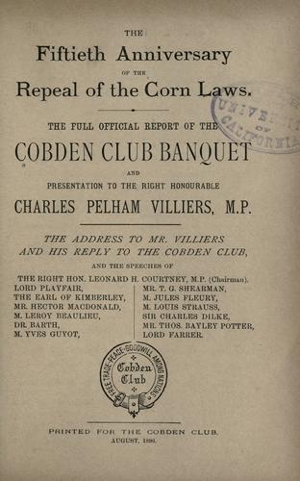 |
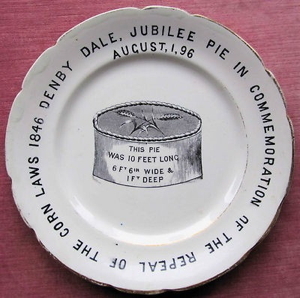 |
|
When the Cobden Club celebrated the Jubilee of Repeal of the Corn Laws a tariff war between the Great Powers of Europe was underway and there were advocates of protection in England as well, most notably Joseph Chamberlain.
|
Supporters of Free Trade could buy this Jubilee Pie Plate to show their solidarity with the movement. The image on the plate shows one of the pies made for the event (10 feet long, 6'6" wide, and 11" deep). On the top it had a crust with a wheatsheaf design.
|
|
Illustration 50: Thackeray, Illustrations Of The Rent Laws I, "Poles offering Corn" (1839)↩ |
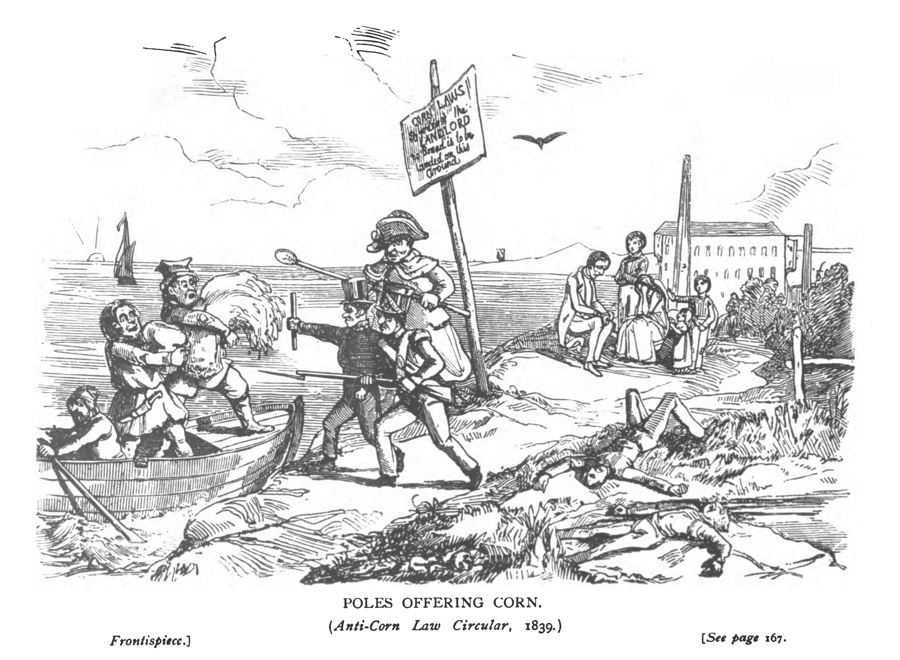 |
|
Source: Stray Papers by William Makepeace Thackeray. Being Stories, Reviews, Verses, and Sketches (1821-1847). Edited, with an Introduction and Notes. By Lewis Saul Benjamin. With Illustrations. (London: Hutchinson and co., 1901). Frontispiece, pp. 167-68, p. 416. Frontispiece: "Poles offering Corn" (Anti-Corn Law Circular, Tuesday, July 23, 1839). [CORN LAWS! By order of the LANDLORD no Bread is to be landed on this Ground.] |
|
Illustration 51: Thackeray, Illustrations Of The Rent Laws II, "The Choice of a Loaf" (1839)↩ |
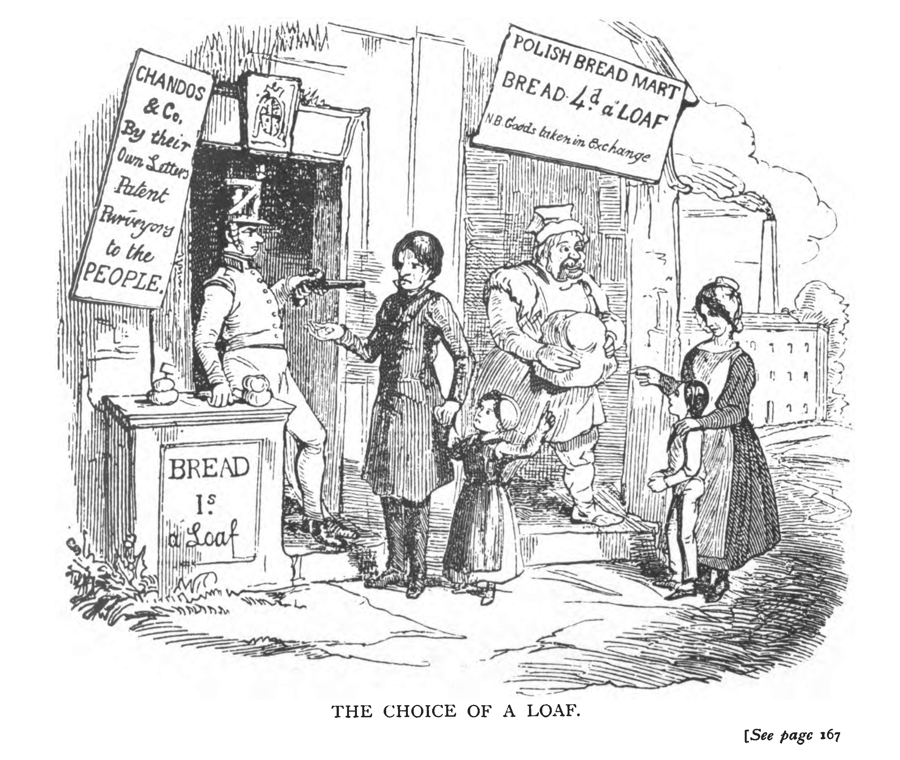 |
|
Source: Stray Papers by William Makepeace Thackeray. Being Stories, Reviews, Verses, and Sketches (1821-1847). Edited, with an Introduction and Notes. By Lewis Saul Benjamin. With Illustrations. (London: Hutchinson and co., 1901). Frontispiece, pp. 167-68, p. 416. p. 416: "The Choice of a Loaf" (Anti-Corn Law Circular, Tuesday, December 10, 1839). [Left: Chandos & Co. By their Own Letters Patent Purveyors to the People. Bread 1 s. a Loaf] [Right: Polish Bread Mart. Bread 4 d. a Loaf. N.B. Goods taken in Exchange.] The illustration accompanied the following text: Pole. Buy my big loaf. I'll sell as cheap as I can. Little Boy. Mammy, I'm hungry. Chandos starves us with a small loaf, and it is so musty, it gives me the belly-ache. Pole. I'll give you this big loaf for a small piece of calico. Woman. My dear boy, that good-natured foreigner— Soldier. Hullo! you she-devil there, none of your smuggling. What's to do, now, you Polish ragamuffin? Would you give a bold Briton a two-shilling loaf for fourpence, and make him as miserable as yourself? Little Girl. Oh, dadda! come away to that nice man with the big loaf. This ugly soldier will shoot us. Soldier. Hullo, missus! d'ye hear? I'll teach ye to deal with foreign serfs by putting a bullet through your head. Come here, you fellow. A bold English peasant mustn't buy from Poles, else I'll show daylight through him. Little Girl. Oh, dadda, run, run! Man. Why, Mary, I must give a shilling for this small bit of bread, like a true, free-born Englishman, else I'll be shot through the head. Woman. I have a piece of calico that took me a week to weave: what will you give me for it? Pole. A quarter of prime wheat. Man. And here must I work four weeks for Chandos before I can get the same quantity. Were it not for the pistol, I'd -, but no, I'm one of "the bold peasantry, the country's pride," and must pay four hundred per cent, for liberty. |
|
Illustration 52: Liberal Party poster: "Free Trade Shop vs. Protection Shop" (c. 1905-10)↩ |
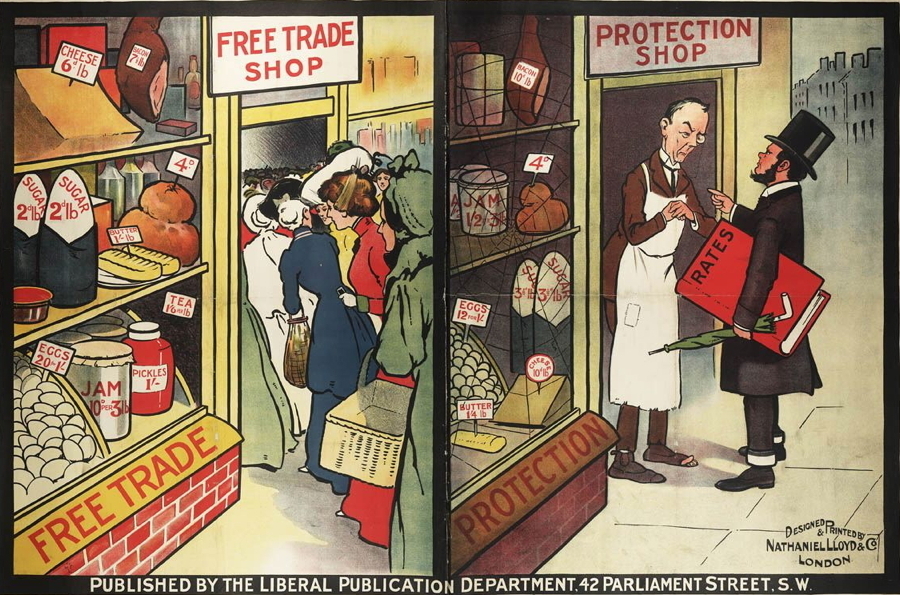 |
|
Source: London School of Economics. British Political Posters, c1905-c1910 <https://www.flickr.com/photos/lselibrary/sets/72157613396150105>. Left: The Free Trade shop is full of goods(note the size of the 4 d. loaf of bread) and customers are lined up to buy things. |
|
Illustration 53: Liberal Party poster: "An Eye Opener" (c. 1905-10)↩ |
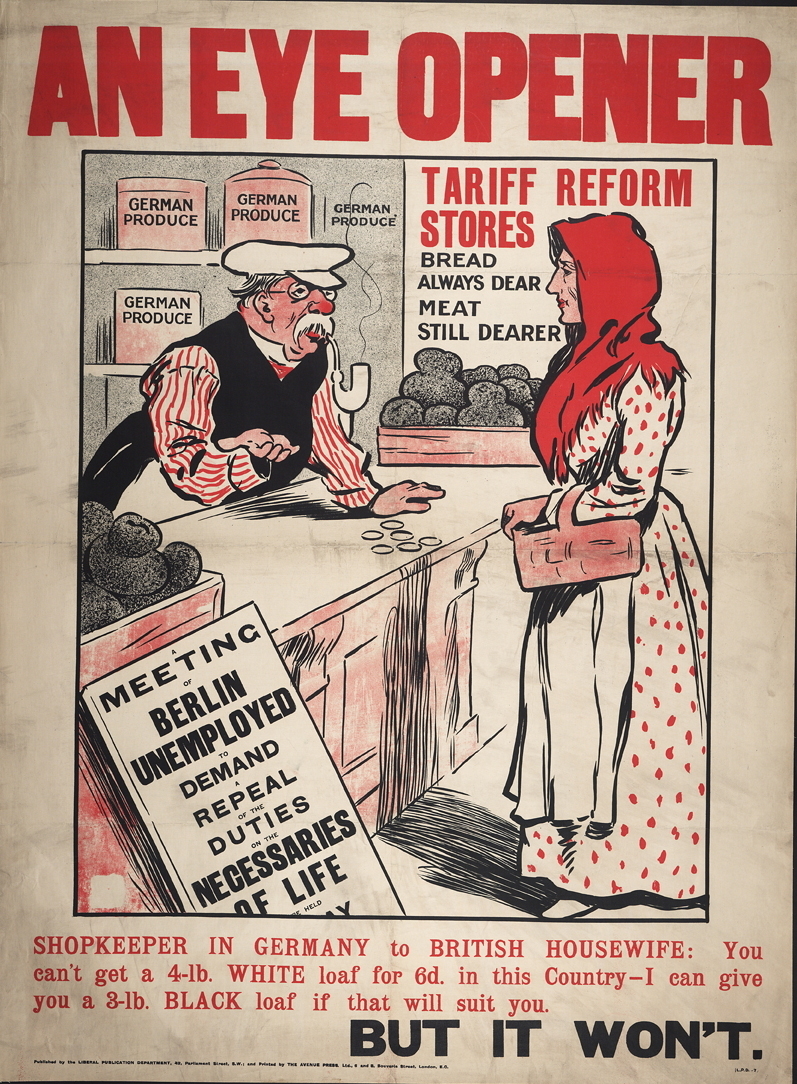 |
|
Source: London School of Economics. British Political Posters, c1905-c1910 <https://www.flickr.com/photos/lselibrary/sets/72157613396150105>. German Tariffs: This poster contrasts the high prices in Germany (which had high tariffs) with what the British housewife is used to in low tariff England. |
|
Illustration 54: Liberal Party poster: "How the Tories Have Increased the Cost of Living" (c. 1905-10)↩ |
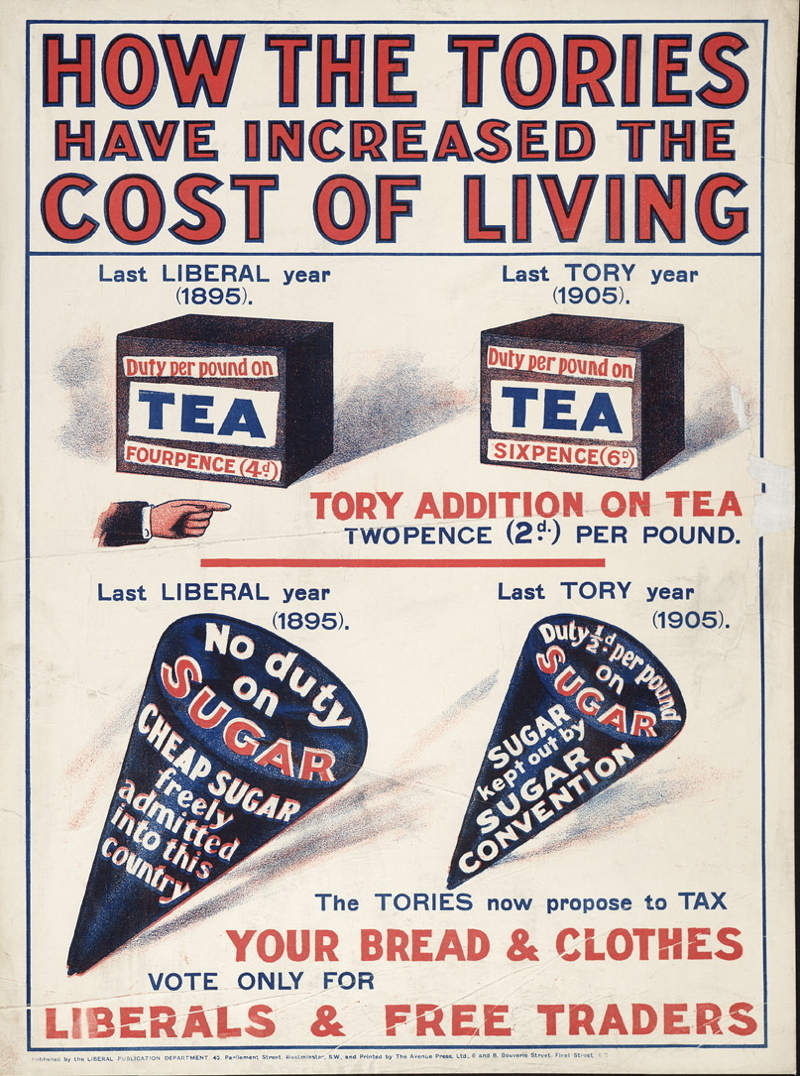 |
|
Source: London School of Economics. British Political Posters, c1905-c1910 <https://www.flickr.com/photos/lselibrary/sets/72157613396150105>. Before and After: The Liberal Party lost power in the election of 1895 to the Conservative Party (the "Tories") but returned to power in a landslide victory in the 1906 election. |
|
Illustration 55: Tariff Reform League poster: "Vote for Tariff Reform" (c. 1905-10)↩ |
 |
|
Source: London School of Economics. British Political Posters, c1905-c1910 <https://www.flickr.com/photos/lselibrary/sets/72157613396150105>. The Election of 1910: In 1910 the Liberal Party lost most of its majority and had to rule in a coalition with other parties. In this protectionist poster the Free Traders are considered to be still in the horse and buggy age (1846) while the Protectionists (the US and the other major European powers) are shown to be more up to date and modern, driving an automobile. |
|
Illustration 56: Imperial Tariff Committee poster: "A Free Trade Forecast" (c. 1905-10)↩ |
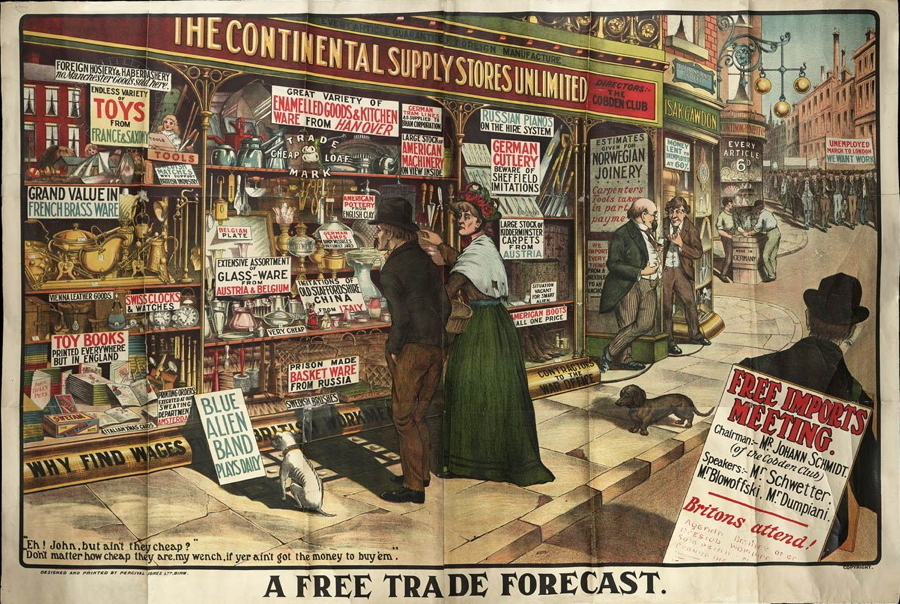 |
|
Source: London School of Economics. British Political Posters, c1905-c1910 <https://www.flickr.com/photos/lselibrary/sets/72157613396150105>. Protectionist Counter-attack: In this poster the protectionists seem to have conceded to the free traders that a "Free Trade shop" would have more goods in the windows, but the argument has shifted to the idea that the foreign goods have been supplied at the expence of British industry and that British workers and housewives can't afford the cheaper prices becuase they are unemployed and have no money. There is considerable anti-foreigner, anti-German and even anti-semitic sentiment expressed here. Note the well dressed man standing under the entrace to the Cobden Club, who is talking to a possibly Jewish money lender, the dachshund standing on the pavement, and the names of the speakers of the "Free Imports Meeting" organised by the Cobden Club ( Mr. Schmidt, Schwetter ("sweater"), Blowoffski, and Dumpiani (dumping)). In the background unemployed workers are marching on London in protest. |
|
Illustration 57: Richard Cobden Obelisk (Map), Cocking Causeway (1868)↩ |
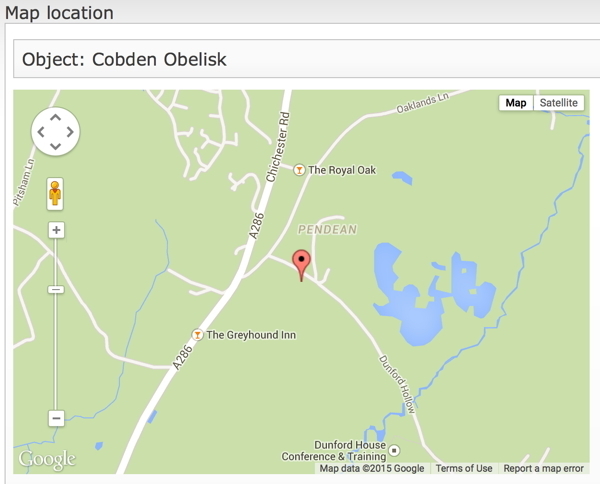 |
|
Map showing the location of Richard Cobden's Obelisk, Cocking Causeway, near West Lavington, West Sussex, Great Britain.
|
|
Illustration 58: Richard Cobden Obelisk 1, Cocking Causeway (1868)↩ |
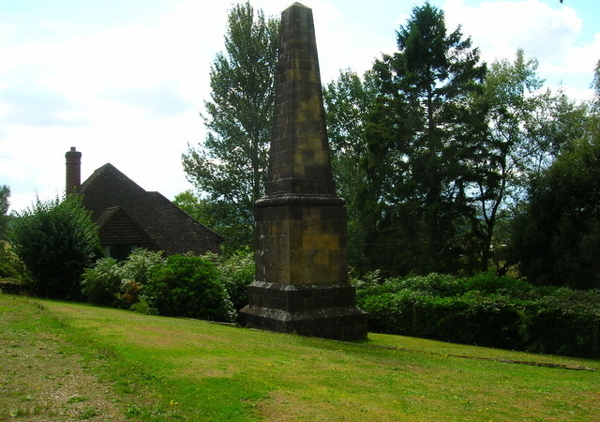 |
|
Cobden lived at Dunford House a mile from where this obelisk was erected in 1868 in his honor (he died in 1865). It was commissioned by H.Y. Court (1868), and the stonemason was J.S. Grist. Source: The Geograph Britain and Ireland project <geograph.org.uk>. Cobden's Obelisk, Cocking Causeway, near West Lavington, West Sussex, Great Britain. <https://www.geograph.org.uk/photo/225586>. |
|
Illustration 59: Richard Cobden Obelisk 2, Cocking Causeway (1868)↩ |
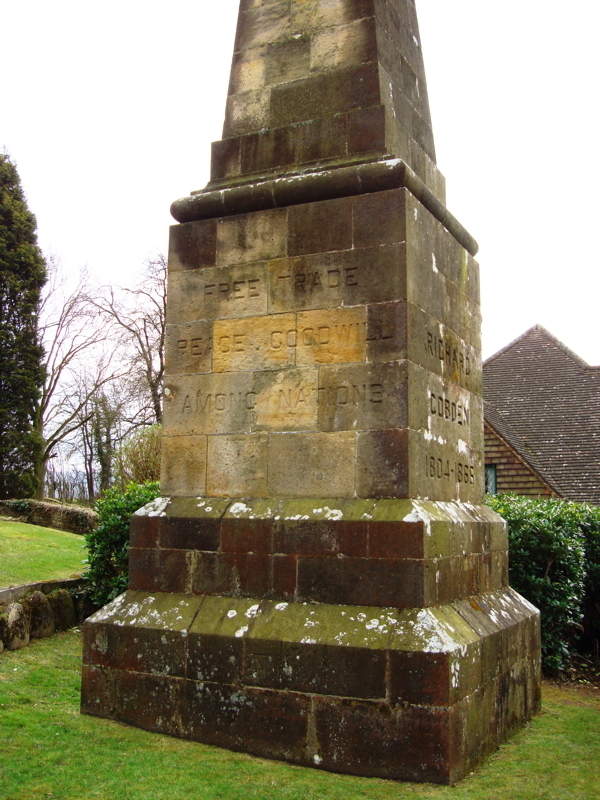 |
|
A more detailed view of Cobden's Obelisk. Inscriptions: Richard Cobden (1804-1865); Free Trade, Peace, Goodwill among Nations. Source: Public Sculptures of Sussex. <https://publicsculpturesofsussex.co.uk/object?id=278>. |
|
Illustration 60: Richard Cobden Obelisk (inscription), Cocking Causeway (1868)↩ |
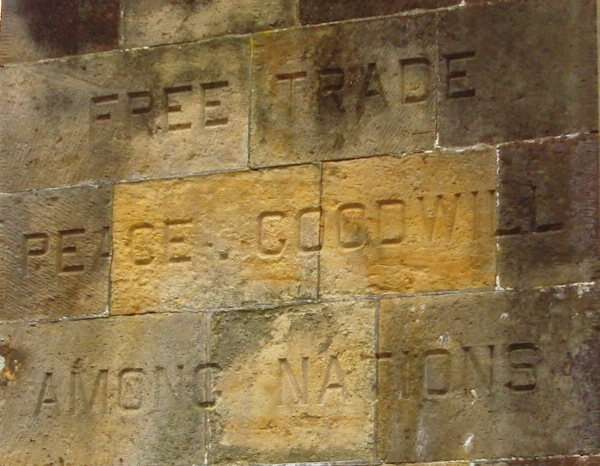 |
|
Inscription: "Free Trade, Peace, Goodwill among Nations"
|
|
Illustration 61: The American Free Trade League: The Free-Trader (1870-71)↩ |
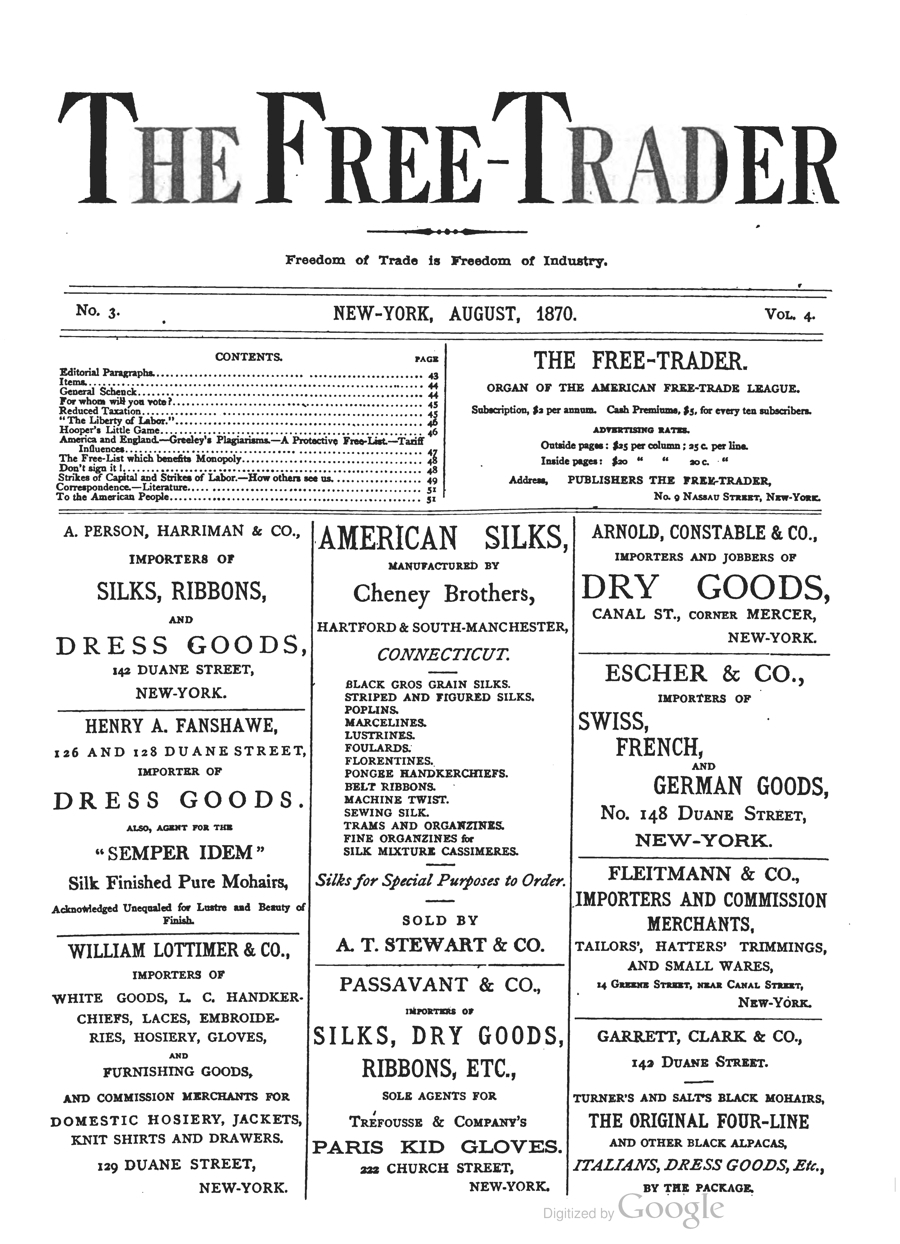 |
|
The American Free Trade League was founded in 1864 by the lawyer Simon Sterne (1839-1901) and the economist and statistician Alexander del Mar (1836–1926) and included among its membership the economist Arthur Latham Perry (1830-1905), the New York politician Horace White (1865-1943), the engineer and economist David Ames Wells (1828-1898), and the essayist Ralph Waldo Emerson (1803-1882). Here we have the title page of their journal The Free-Trader (1870) and an advertisement for a popular newspaper with cartoons and other images. Note the large number of classified ads on the front page and the motto of the journal "Freedom of Trade is Freedom of Industry". |
|
Illustration 62: The American Free Trade League: The People's Pictorial Tax-Payer (1870)↩ |
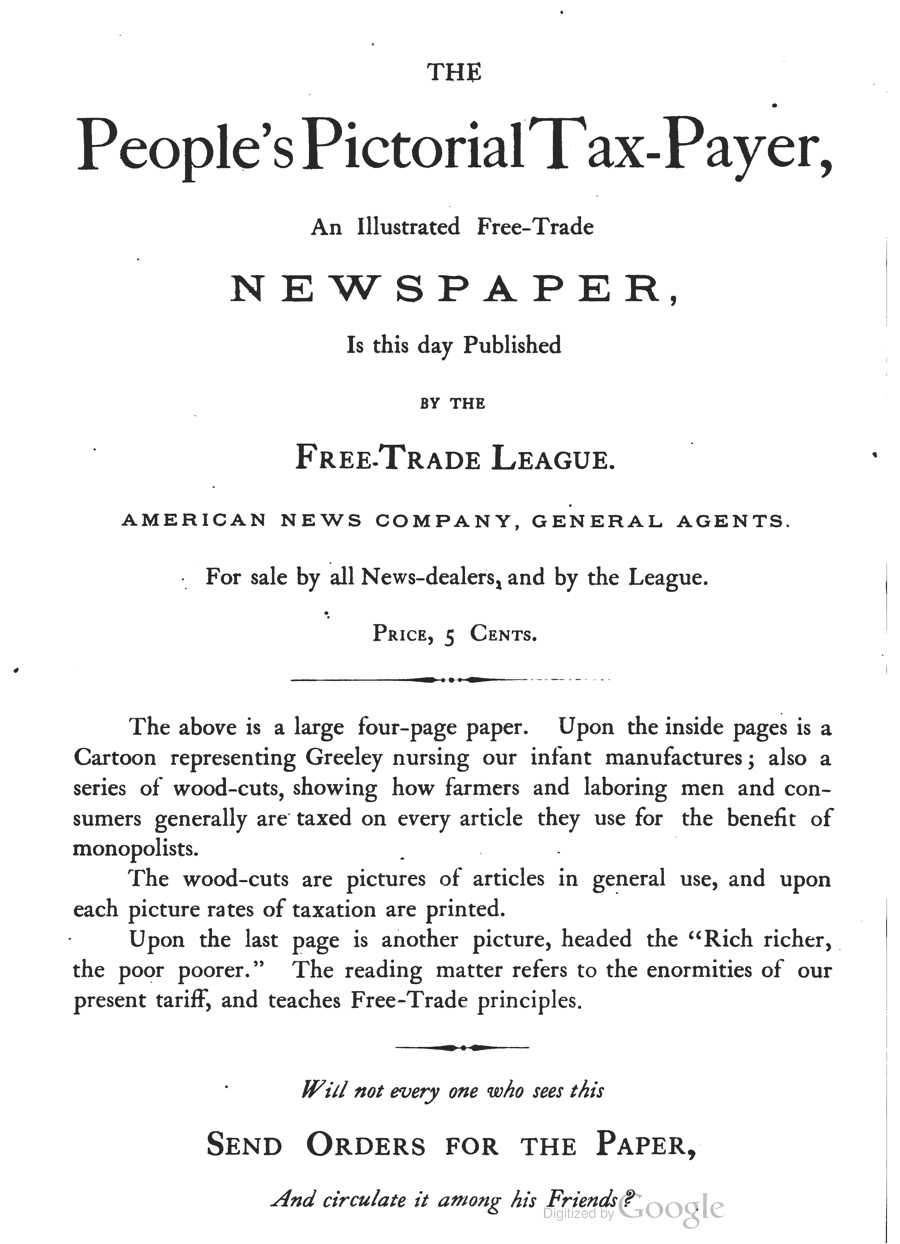 |
|
Here is an advertisement for a 4 page "illustrated Free Trade newspaper" which contains the following: "Upon the inside pages is a Cartoon representing Greeley nursing our infant manufactures; also a series of wood-cuts, showing how farmers and laboring men and consumers are taxed on every article they use for the benefit of monopolists. The wood-cuts are pictures of articles in general use, and upon each picture rtes of taxation are printed. Upon the last page is another picture, headed "Rich richer, the poor poorer." The reading matter refers to the enormities of our present tariff, and teaches Free-Trade principles." |
|
Illustration 63: The New York Free-Trade Club: Statement of Principles (1883)↩ |
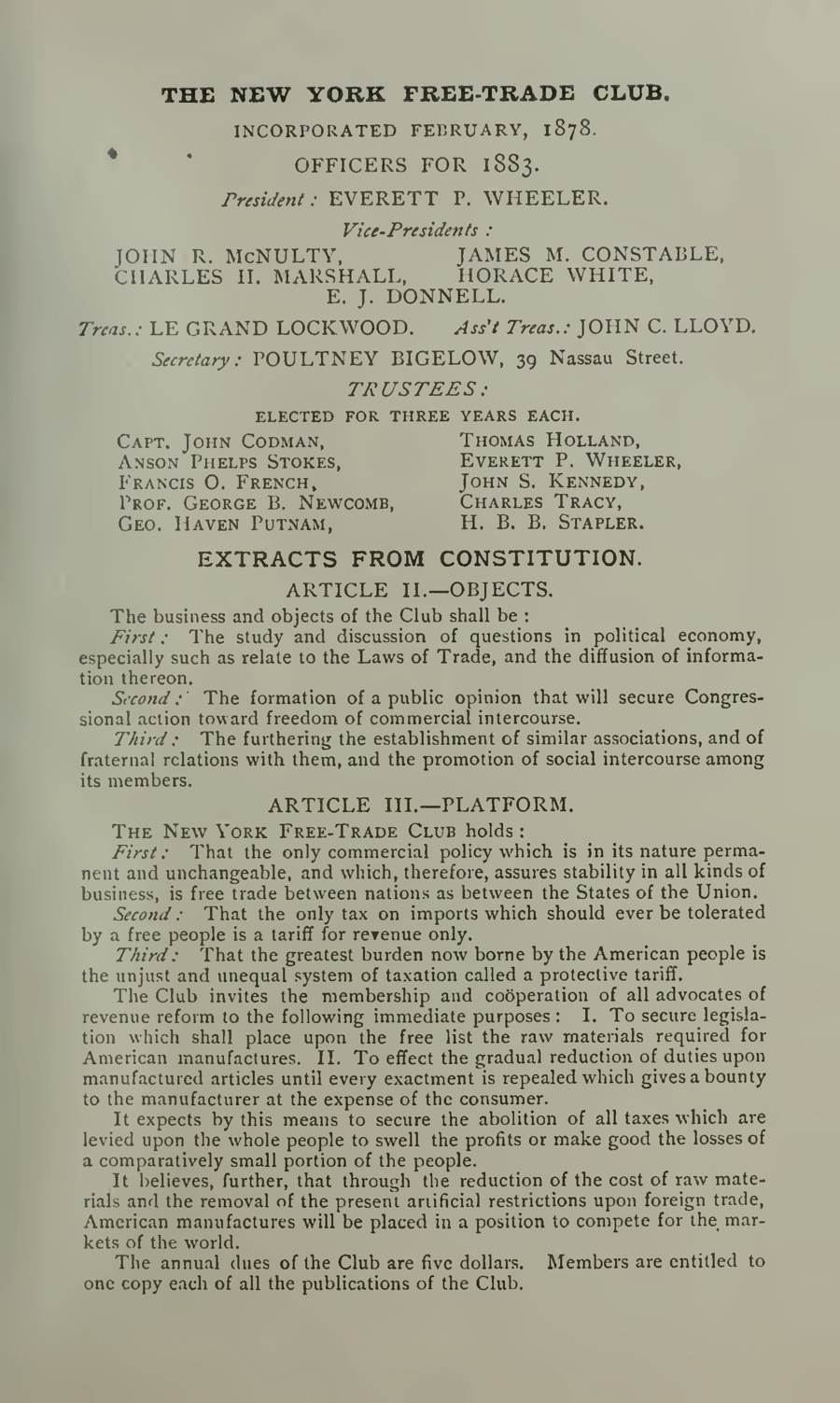 |
|
Here we have a list of the new officers for 1883 and a statement of principles, and an advertisement for their "Cheap Literature". According to Article III, their Platform the NYFTC holds: First: That the only commercial policy which is in its nature permanent and unchangeable, and which, therefore, assures stability in all kinds of business, is free trade between nations as between States of the Union. Second: That the only tax on imports which should ever be tolerated by a free people is a tariff of revenue only. Third: That the greatest burden now borne by the American people is the unjust and unequal system of taxation called a protective tariff. The Club invites the membership and cooperation of all advocates of revenue reform to the following immediate purposes: I. To secure legislation which shall place upon the free list the raw materials required for American manufactures. II. To effect the gradual reduction of duties upon manufactured articles until every exactment is repealed which gives a bounty to the manufacturer at the expense of the consumer. It expects by this means to secure the abolition of all taxes which are levied upon the whole people to swell the profits or make good the losses of a comparatively small portion of the people. It believes further, that through the reduction of the cost of raw materials and the removal of the present artificial restrictions upon foreign trade, American manufacturers will be placed in a position to compete for the markets of the world. |
|
Illustration 64: The New York Free-Trade Club: "Cheap Free-Trade Literature" (1883)↩ |
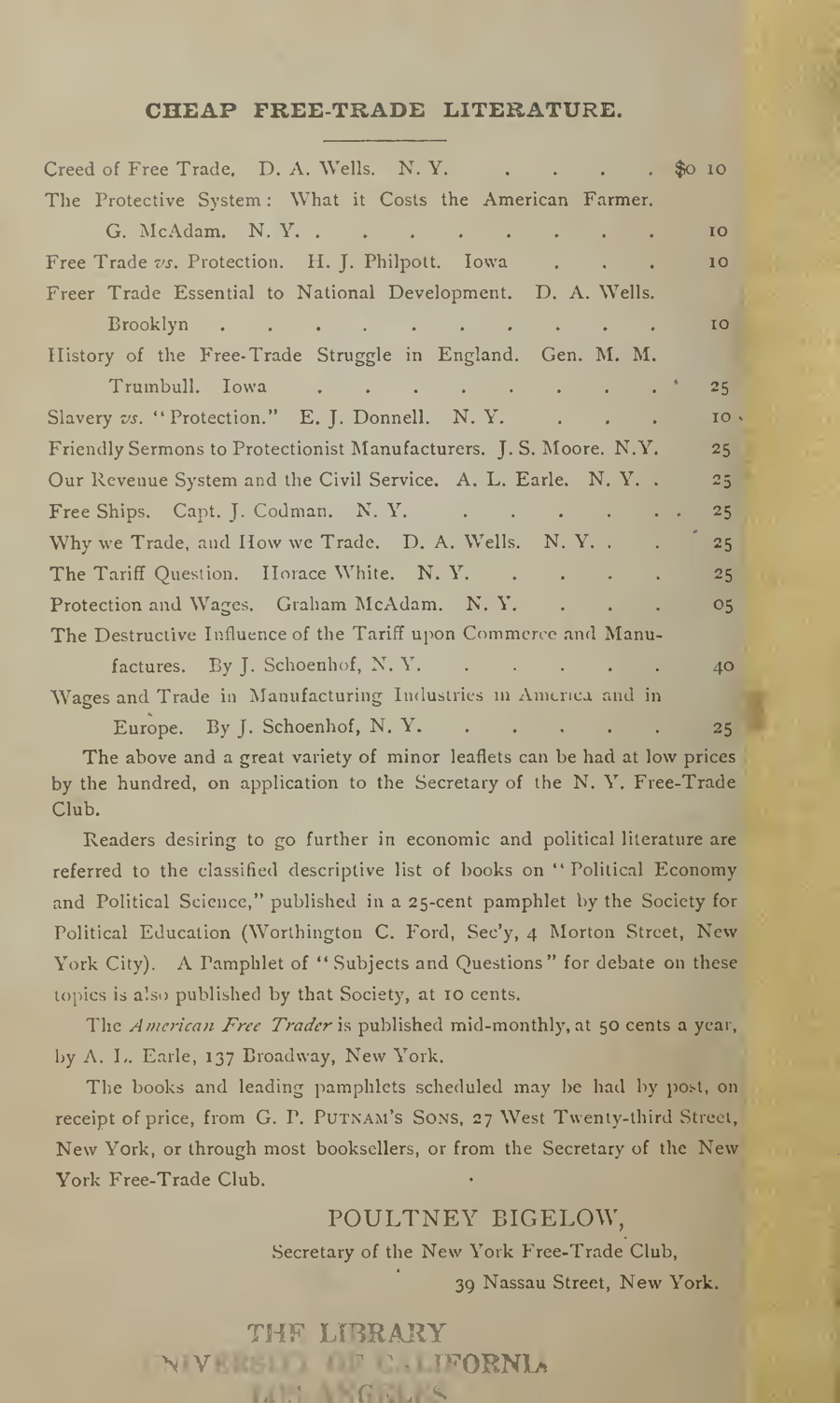 |
|
Here we have a list of the Club's "Cheap Free-Trade Literature" which ranges in price from 10 cents to 40 cents. It further states that "The above a great variety of minor leaflets can be had a low prices by the hundred, on application to the Secretary of the N.Y. Free-Trade Club. Readers desiring to go further in economic and political literature are referred to the classified descriptive list of books on "Political Economy and Political Science," published in a 25-cent pamphlet by the Society for Political Education ... The American Free-Trader is published mid-monthly, at 50 cents a year... |
|
Illustration 65: The New York Free-Trade Club: Dinner Menu at Delmonico's (1885)↩ |
Illustration 66: The New York Free-Trade Club: Dinner Toasts at Delmonico's (1885)↩ |
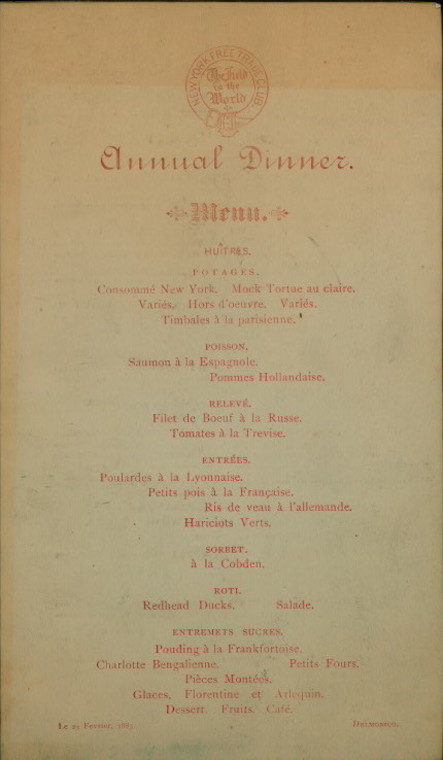 |
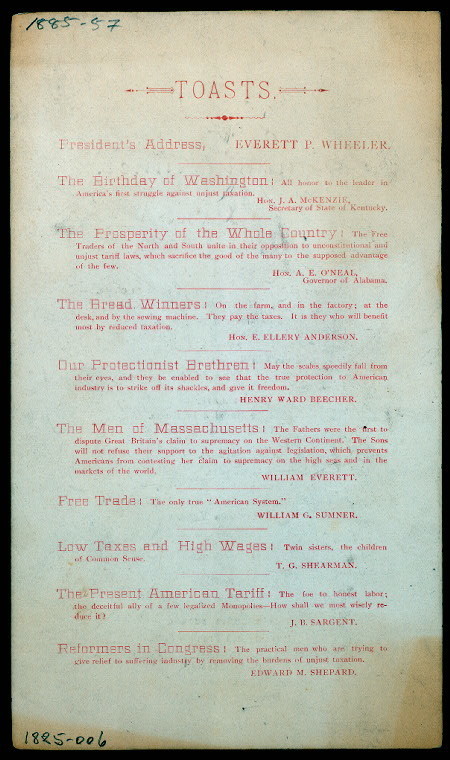 |
|
Here is a menu for a Club banquet held at Delmonico's restaurant in New York in February 1885 with the toasts given on the reverse side of the page. Note the logo of the Club "The ?? is the World" and the "Sorbet à la Cobden".
|
Of the toasts, note especially "The Birthday of Washington" given by McKenzie ("All honor to the leader of America's first struggle against unjust taxation") and that by William Graham Sumner "Free Trade: The only true "American System"".
|